St. Paul - "This is more than an investment—it's a commitment to creating a bold, diverse, and just economy," said Tawanna A. Black, Founder and CEO of the Center for Economic Inclusion. "These businesses are job creators, innovators, and a driving force behind inclusive economic growth. By supporting them, we are laying the foundation for Minnesota’s economy to be more competitive and equitable for everyone."
May D. Vang Named to Center for Economic Inclusion’s Board of Directors
Who are your subcontractors? Why organizations at the forefront of racial equity are measuring Tier 2 supplier diversity
By Maggie Dalton, Senior Analyst
Buying goods and services from businesses owned by Black, Indigenous, Latino, and Asian people enable companies to benefit from new ideas and access new markets. That’s why more leaders in the private and public sectors are recognizing that their organization's supplier base is a critical lever for building a racially equitable economy.
A racially diverse local supplier pool can bring greater resilience and new resources into historically underinvested communities, building individual and community wealth. But robust supplier diversity efforts go beyond valuing racial diversity among direct suppliers — these efforts recognize that a supplier's subcontractors, or Tier 2 suppliers, matter, too.
That’s why one of the racial equity standards in the forthcoming 2023 Racial Equity Dividends Index is: Does your organization measure the racial diversity of its Tier 2 suppliers?
Standards related to procurement show some of the greatest opportunity for improvement among organizations who participated in the 2022 Racial Equity Dividends Index.
Just 39% of organizations who participated in the 2022 Racial Equity Dividends Index have an enterprise-wide practice of collecting and sharing data on the racial diversity of suppliers. Measuring the racial diversity of Tier 2 suppliers is a new standard for 2023.
Supplier diversity programs, which seek to build a diverse supplier base within organizations, have existed for decades, though it remains an area of business practice that is quickly evolving. Many businesses are just beginning their supplier diversity journeys, leading to a real competitive advantage for those who focus on diversifying in this area.
Research finds that diverse suppliers increase innovation, competition, and resilience throughout the value chain and unlock additional value, both for businesses and regions through increased business activity and economic growth. Moreover, investing in minority-owned businesses is investing in building prosperity in Black, Indigenous, Hispanic, and Asian communities.
Due to historic patterns of underinvestment, Black, Indigenous, Hispanic, and Asian-led firms often have smaller revenues and staff than white-led companies and may be better positioned to start with smaller contracts and grow. Also due to their smaller size, these businesses are the ideal candidates for subcontractors or to deliver on specialized requests that primary contractors are unable to provide. Investing in minority-owned businesses as Tier 2 suppliers can provide on-ramps for suppliers of color, enabling them to grow, scale, and add capacity over time.
Beyond tracking Tier 2 spend for themselves, research from the Center for Economic Inclusion finds that procuring companies have the ability to influence Tier 1 suppliers to track and adopt measures of their own progress in subcontracting across their entire portfolio with businesses owned by people of color, therefore further expanding their influence.
For example, in 2019, Ford launched the Widening the Inclusion Network (WIN), designed to “further develop their existing supplier diversity programs through coaching, mentorship, and thoughtful partnerships with other diverse businesses.” Ford is leading the way by investing not only in businesses, but in relationships.
At the Center, we help companies implement promising practices to build racial equity for their workers and their communities. The Racial Equity Dividends Index is one tool we offer to help businesses measure their progress toward building a racially equitable and inclusive workplace.
The Index includes 43 racial equity standards across seven categories that support racial equity in workplaces: Leadership; Hiring; Culture, Retention, & Advancement; Procurement; Philanthropy & Investment; Public Policy; Products & Services.
We know many companies are leading the way in tracking Tier 2 supplier diversity as a part of growing supplier diversity initiatives.
Encourage your company to join the movement and evaluate progress towards building racially equitable and inclusive workplaces – workplaces that pay dividends for everyone.
If your company is interested in taking the next step to measure and continue building a racially equitable and inclusive workplace, be sure to register for the 2023 Index by March 10 to receive your confidential results and find out how your organization compares to others in your industry.
Register for the 2023 Racial Equity Dividends Index
How the Racial Equity Dividends Index Helps Companies Build Racially Equitable and Inclusive Workplaces
Index Registration Open Through March 8
In January 2021, the Center for Economic Inclusion (Center) launched the first-ever Racial Equity Dividends Index (Index), a comprehensive analytical tool to help companies assess how their current policies and practices position them to win on racial equity and advance business goals, while also identifying opportunities for improvement. Since then, more than 100 public and private organizations have used this assessment to navigate their efforts to close racial wealth gaps.
We sat down with Nathan Arnosti (Director of Analytics and Index project lead) to talk about the Index, now open for registration through March 8.
What is the Index?
(Nathan) The Racial Equity Dividends Index (Index) is an analytical tool designed to support private-sector businesses in their journeys to build racially equitable and inclusive workplaces. The Index offers companies an intuitive, comprehensive, and measurable roadmap for progress on racial equity.
How can my business register for the Index?
(Nathan) First, eligible companies – currently, all private-sector organizations with offices in Minnesota – register online for the Index at the Center’s website. Then, once registration closes on February 24, registered businesses will receive the 2023 Private Sector Index survey and have approximately four weeks to complete it.
What information is gathered through the Index survey?
(Nathan) Through a series of multiple-choice questions, the survey asks companies to report their progress against 43 racial equity standards spanning seven dimensions of company operations, such as hiring, procurement, leadership, and products and services. It also provides companies the opportunity to gather and share data on workforce demographics and supplier spending.
What happens next?
(Nathan) The survey responses inform two sets of analytical Index products that are delivered to participating companies. First, participants receive a customized score report that provides their full answers alongside peer comparisons and recommendations developed by the Center for Economic Inclusion, so that companies can learn what their strengths are and where opportunities lie. Next, companies are included in the Racial Equity Dividends Index Report that aggregates responses across companies, identifying trends, elevating promising practices and case studies, and celebrating leading employers in each category. The 2022 Index report is available on our website.
Why is it important for companies to participate?
(Nathan) Spurred by the murder of George Floyd by Minneapolis police officers and the largest protests in American history in 2020, businesses pledged to reshape existing practices and committed record-setting investments in historically disadvantaged Black, Indigenous, Hispanic, and Asian communities.
At the same time, we know that businesses often lack a roadmap for what racial equity can look like or clear standards against which to measure their actions. They also have very limited information about how their actions compare to peers.
The Index is a tool designed to meet these needs – to help companies make tangible, durable progress towards building racially equitable and inclusive workplaces that drive innovation, productivity, retention, and belonging.
Who is the target audience?
(Nathan) We’ve designed the Index for all private-sector companies in all industries. In our experience, companies with at least 50 employees find the Index most valuable.
In 2022, companies of all sizes participated in the Index -- executive recruiting firms with fewer than 100 employees, to manufacturing companies with several hundred or thousand employees, to Fortune 500 companies, like Best Buy or 3M.
This Index offers companies the opportunity to learn from one another, regardless of sector or size, and I see that as a key part of its value. Participating companies were particularly compelled by the opportunity to assess their results alongside similar employers in a customized sector report.
What were some of the biggest learnings from the Racial Equity Dividends Index?
(Nathan) We learned that there is a tremendous appetite among private-sector leaders for analytical tools that offer a clearly defined, measurable roadmap to build racially equitable workplaces. In its first year, 40 companies that collectively employ more than 200,000 Minnesotans participated in the Index, even though it was a novel and unprecedented initiative. We’re excited to connect with even more businesses to encourage them to participate and take advantage of the Index this year.
QUESTIONS
For more information about the Racial Equity Dividends Index, please see the registration page, FAQ page, download the Index brochure, or email us at index@centerforeconomicinclusion.
Our $65 Billion Opportunity: How Investments in Racial Equity and Inclusion Will Impact Communities and the Economy for the Better
By Isaac Russell, Director of Public Policy
On January 24, Governor Tim Walz made national headlines with his proposed $65 billion 2024-2025 fiscal biennium budget, the largest in Minnesota history. The Governor understands that addressing the state’s economic, social, and infrastructure needs on this scale requires big money. The state’s unprecedented $17.6 billion budget surplus will also come into play.
This is our moment -- Minnesota’s once-in-a-generation opportunity to chart and build a racially equitable, inclusive, and sustainable path forward that has rippling impacts on the state’s families and economy for years to come.
Policy Leadership
While I’ve led the Center’s public policy for just over a year, the organization has had a strong presence at the Capitol for nearly five. Bold social and economic policy change requires tenacity, strategy, and partnerships.
What I can also tell you is this: There has never been a better time for initiatives that have a strong racial equity component than right now. And with this unprecedented amount of money, I urge organizations that are doing racial equity work to offer solutions that are more systemic in nature.
New Day Dawned
As I walk the capitol corridors, the change in the air is palpable. It’s a powerful thing to witness leadership of color in both chambers shaping and passing legislation that prioritizes the experiences of and impacts to Black, Indigenous, Latino, and Asian communities in new ways.
Less than two months into session, this momentum has already resulted in significant policy change. The CROWN Act signed into state law. Juneteenth designated as a state holiday. Plus, there are proposals to establish new offices that prioritize Black health and missing and murdered Black women.
This is what progress and momentum looks like. My responsibility to lobby for the Center’s public policy priorities – Racial Equity Impact Notes, $10 million direct appropriation for job creation, and increasing the state procurement and preference equity cap -- is made easier by the partnerships there now that weren’t in previous years. We are strengthening relationships and forging new ones.
There is no time to waste. Let’s get into it.
$65M Budget Highlights
Here’s a budget breakdown of what I see as key investments towards a more racially equitable and inclusive state.
1. Investments focused on employment, wages, and wealth-building in Black, Indigenous, Latino, and Asian communities. This includes targeted investments in small business supports, workforce programs, and homeownership that recognize and address historic and systemic disinvestments and barriers that have hindered Minnesota’s economic competitiveness.
2. Investments in businesses along commercial corridors. Examples: the $85 million proposed funding to the Mainstreet Revitalization Fund along with funding for Small Business Navigation Program, Small Business Development Centers, and the Small Business Partnerships Program are critically important to creating jobs, building wealth, and growing our economy.
Through these programs, we hope to see increased coaching, access to flexible capital like forgivable loans, and small business consulting. We also need to ensure these programs have a strong racial-equity orientation with significant outreach to minority-owned businesses.
3. Advancing racial equity in Minnesota’s workforce. The Governor’s budget aims to increase family sustaining wages for Black, Brown, and Indigenous workers by recommending $60 million in training and employment services for workers traditionally overlooked.
4. Emphasis on developing workforce opportunities for family sustaining wages, which is one of the metrics we use to evaluate if our economy is racially equitable and inclusive.
5. Proposed funding for increasing home-care workers’ rates. This action would provide an increase to over 20,000 workers statewide. We define a living wage as a worker who earns at least $39,795 annually, of which only 49 and 44 percent of Black and Hispanic workers earn, respectively.
6. Expansion of the Child Tax and Dependent Credit. Estimates show this would help roughly 100,000 households with child-care costs. Families that earn less than $200,000 could get up to $4,000 if they have one child, $8,000 for two, and $10,500 for three. A child tax credit for lower-income Minnesotans could give families $1,000 per child, up to $3,000.
7. $1 billion expansion of housing funding. This amount includes funding for rental assistance, workforce and affordable homeownership, assistance to those facing homelessness, and workforce housing.
While $1 billion is a large number, even more is needed. The Twin Cities alone faces a housing shortage of at least 45,000 affordable units. This number does not take into account the struggles of families trying to purchase their first home. While there is some funding for the construction of affordable homes and home down-payment assistance, we know more resources are needed.
Committing to the Long Term
While the Governor’s budget makes historic investments in Minnesota and includes a strong equity component, we know that racial equity and inclusive growth will require sustained efforts across time and at different levels of government.
It will mean strong leadership to carry the work forward beyond the next two years and from one administration to the next to keep Minnesota moving forward for all Minnesotans.
We can do it.
What’s New: Introducing the 2023 Racial Equity Dividends Index for the Private Sector
By Nathan Arnosti, Director of Analytics
A year ago, the Center for Economic Inclusion launched the inaugural Racial Equity Dividends Index (Index). The Index surveys participating companies on their policies and practices related to 43 Center-identified racial equity standards that span seven dimensions of company activity.
Participating companies receive customized score reports that help them assess their strengths and opportunities on racial equity, understand how they compare to peers, and chart a roadmap for further action. Additionally, a public Index report identifying high-scoring businesses, trends, and case studies is published on the Center’s site as a free resource for companies.
Forty companies of all sizes – from Fortune 500s to enterprises with fewer than 100 employees, and collectively employing more than 200,000 Minnesotans – participated in the Index last year. With the results of this index in-hand, these organizations have used their unique results to focus their efforts to drive racial equity forward within their organizations.
The Center offers the Index to companies on an annual basis. We believe that to sustain excellence, the Index must adapt to reflect new research and thinking on standards that best advance racial equity within companies.
These are several of the questions that the upcoming 2023 Racial Equity Dividends Index for the Private Sector seeks to answer:
How many businesses in Minnesota no longer use a new hire’s salary history to determine their salary?
Do businesses provide hourly workers with consistent schedules and the ability to work full-time?
Does your organization measure the racial diversity of its Tier 2 Suppliers (your suppliers’ suppliers)?
What’s new in 2023
After we published the 2022 Index results last June, I led a team of Center colleagues to revisit and re-evaluate our racial equity standards. Integrating feedback we received from participating companies, new research which included the Center’s own research on racially equitable procurement and policymaking practices, and emerging models from racial equity practitioners, the 2023 Index offers the following additions:
New sections to collect data on racial equity outcomes at your organization. In these sections, participating companies report on critical datapoints related to their workforce and supplier diversity, including:
Racial demographics of their workforce at different levels, including senior leadership, supervisors, all full-time staff, and all part-time staff;
Number of workers by race who earn family-sustaining wages, are hired, receive promotions, and depart; and
Number of and total investment in Black, Indigenous, Hispanic, or Asian-owned suppliers.
These sections will not count towards an organization’s score, but we believe they will provide invaluable insight into baseline outcomes of participating companies compared with peers, which will be shared with each organization in their confidential Index score report
Seven new racial equity standards. Our team has developed new standards related to the use of salary histories during hiring processes, protocols to ensure that Black, Indigenous, Hispanic, and Asian-owned businesses are considered in requests for proposals, corporate transparency around lobbying efforts, and more. We believe these new standards will shed new light on the opportunities for building – and benefitting from – racially equitable workplaces.
Revisions to several existing Index standards. Based on feedback we received from participants, new research, and an analysis of 2022 results, we’ve revised a handful of standards so that they offer clearer, more compelling insights. The 2023 Index gathers more specific data on the action businesses take to reduce bias within the application process, benefits they offer their employees, and efforts to provide antiracist training to employees. We’re excited to share these revised standards with participating companies in the 2023 Index survey.
We believe the 2023 Racial Equity Dividends Index is the tool that companies need to strengthen and deepen their existing efforts to build racially equitable and inclusive workplaces – and benefit from the innovative ideas, increased productivity, improved retention, and higher satisfaction and engagement that can result.
The updates we’ve made to the Index over the past six months further strengthen its value. Dismantling racially inequitable systems and building organizations and economies that benefit all of us is a daunting undertaking. With tools like the Index to support and accelerate the efforts of dedicated leaders within organizations, we believe that progress is possible.
Registration for the 2023 Racial Equity Dividends Index for the Private Sector is open now through February 24. Don’t miss this opportunity to participate! bit.ly/2023-Index
Please see our FAQ page for additional information about the 2023 Racial Equity Dividends Index for the Private Sector and direct any questions about the Index to index@centerforeconomicinclusion.org.
Center for Economic Inclusion releases innovative data, tools to measure and track Twin Cities’ economic inclusivity
Center’s Indicators for an Inclusive Regional Economy and first-ever Racial Equity Dividends Index identify areas for improvement in region’s pursuit of workplace and economic inclusion
The Center for Economic Inclusion today unveiled its 2022 Indicators for an Inclusive Regional Economy and the first-ever findings from its new Racial Equity Dividends Index during its Powering Inclusion Summit, the State of Racially Inclusive Economic Growth & Employer Action. Shared with Index participants and the Twin Cities business, government, and community leaders in attendance at the summit, together, the interactive Indicators website and Racial Equity Dividends Index can be used as powerful tools to help identify challenges and implement solutions to build an economy for everyone.
“For more than two years, businesses have made bold declarations to address racism. Those who are ultimately instrumental in Minnesota’s elevation from worst in the nation for African Americans, to best in the nation for African Americans and business growth and economic prosperity, will be those who adopt systemic frameworks rooted in anti-racism and liberation that honor the brilliance in communities of color,” said Center for Economic Inclusion Founder and CEO Tawanna A. Black.
“The Center’s first-ever Racial Equity Dividends Index gives leaders the proven standards to guide their strategies and goals and the 2022 Indicators for an Inclusive Regional Economy guides organizations in establishing goals for both internal performance, and the resulting impact on the regional economy.”
About the Racial Equity Dividends Index
The Racial Equity Dividends Index is a comprehensive tool that businesses opt into to measure their progress toward building inclusive workplaces in Minnesota. A total of 40 businesses participated in the first-ever Index this spring, which measured performance on the leading standards of racial equity, inclusion and belonging. These 40 participating companies employ more than 200,000 workers in Minnesota, and an additional 550,000 employees elsewhere in the world, meaning approximately one in every 12 non-government employees in Minnesota works for a company participating in the Index.
The Index scores participating companies on the leading standards to advance anti-racism, inclusion and belonging in seven categories including: leadership; hiring, culture, retention, and advancement; procurement; products and services; philanthropy and investments; and public policy. Participating organizations were evaluated and received scores ranging from 6 to 76 points out of a possible 100. The average company score was 38, with final totals significantly varying. On average, the larger organizations scored higher overall and in every Index category, likely reflecting their greater access to resources and staff capacity compared to smaller organizations.
Index data found participating companies scored highest in racial equity standards related to leadership, culture, and retention and advancement, with the greatest opportunities across the board for improvement in racial equity standards related to participant’s products and services, procurement, public policy, and philanthropy and investment.
Analysis of participating companies by industry indicates that manufacturing companies scored higher in hiring and leadership; organizations in finance and insurance scored higher in philanthropy and investment; and health care and social assistance organizations scored higher in public policy and products.
About the Indicators for an Inclusive Regional Economy Digital Lab
The Indicators for an Inclusive Regional Economy evaluates key measures of inclusive economic growth and competitiveness while offering profiles of data by race and income. The digital lab on the Center’s website also offers tools and case studies for closing racial wealth gaps and addressing workplace racial equity and inclusion opportunities.
This newly updated data demonstrates that Minnesota’s employers and policymakers must take more deliberate, aggressive, and sustained action and make anti-racist, systemic investments to not only close racial wealth gaps and position the state to compete in the global economy, but to ensure all people experience the racial and economic justice, inclusion and belonging we value and deserve. The data highlight the many existing barriers to quality, well-paying economic and employment opportunities for all Minnesotans, despite historic levels of job openings and the need for additional workforce labor.
Recent employment rates have significantly differed across racial, ethnic, and culture groups, with Black, American ancestry, Somali, and Indigenous residents employed at a rate of 54% compared to more than 80% for Puerto Rican, Korean, and Indian residents; further studies have revealed that workers of color are often the first to be laid off and the last to be hired for full employment. Racial discrimination in the employment process is also still prevalent, with more than three in four Black, Indigenous, Hispanic and Hmong residents having reported experiencing racial discrimination when applying for a job.
Over the past five years, the Center for Economic Inclusion has quickly grown and emerged as a regional leader in building, scaling, and institutionalizing anti-racist workplaces. By working alongside organizations to better understand and implement current research findings, the Center hopes to build a thriving, resilient regional economy where everyone can participate in markets, advance in careers and build wealth, and drive overall economic growth. Quality, consistently updated data through tools like the Indicators for an Inclusive Regional Economy and the Racial Equity Dividends Index are critical for identifying the challenges, taking note of the opportunities, and acting on tangible, research-driven solutions.
To learn more about the Racial Equity Dividends Index and to read the full report, click here.
To explore the Indicators for an Inclusive Regional Economy digital lab, click here.
Center for Economic Inclusion and Growth & Justice Form New Strategic Alliance
St. Paul, Minnesota — A new strategic alliance that will transfer the resources and assets of Growth & Justice to the Center for Economic Inclusion was announced Wednesday by leaders of the two organizations.
“For 20 years, Growth & Justice has been at the forefront of supporting communities across the state in developing policies to generate inclusive economic growth and equitably distribute opportunity in ways that close racial and spatial disparities. Minnesota’s diverse economy will thrive because of its diverse racial and ethnic populations and our willingness to foster racial inclusion and belonging. We are grateful to the leaders of Growth & Justice for capitalizing on this opportunity to leverage their legacy and assets by investing in the future impact of the Center for Economic Inclusion for the good of all Minnesotans,” said Tawanna A. Black, Founder and Chief Executive Officer of the Center for Economic Inclusion.
“This acquisition combines and magnifies efforts by both organizations to advance racial and economic justice,’’ said Jane Leonard, president of Growth & Justice. “Both our organizations have emphasized that racial equity and inclusion are beneficial and necessary for business and community vitality. We are thrilled that the Center for Economic Inclusion will now be able to use our Minnesota Equity Blueprint and Minnesota Equity Map to bring special attention to successful efforts in rural and Greater Minnesota, complementing the Center’s focus on the Twin Cities metropolitan area.’’
"We are immensely grateful for the support we have received from thousands of people and dozens of partner organizations over the last 20 years," Leonard added. "And we are encouraging all our supporters and donors to now help the Center for Economic Inclusion as it carries the spirit and substance of our work forward."
~~~~~~~
About Growth & Justice
Growth & Justice, founded in 2002, has been a leading think tank in Minnesota, focusing on research and advocacy for statewide public policies that advance racial and economic justice, making a case that a more widely shared prosperity drives healthier economic growth. G&J has been particularly influential in education and workforce issues, as well as tax-and-budget policy.
G&J has published dozens of reports and hundreds of commentaries over the last two decades, advocating for more investment in equitable post-secondary attainment, early childhood education, climate action, and for universal and affordable health care.
A crowning achievement was the publication in 2020 of the 165-page Minnesota Equity Blueprint, a constructive and comprehensive guidebook of policy proposals and best practices statewide that address racial and regional disparities and climate change.
Further detail on the legacy of Growth & Justice: timeline summarizing major milestones and achievements for Growth & Justice.
Center for Economic Inclusion Wins $5 Million from JPMorgan Chase for Accelerator and Fund for Black and Latina Women-Owned Businesses
Project Vanguard and the Vanguard Fund, a new effort led by the Center for Economic Inclusion in partnership with the Certified Access Initiative powered by Activate Network and Fearless Commerce, and NEOO Partners Inc., are one of six projects awarded nationally to invest in Black and Latina women business owners
February 3, 2022 (St. Paul, MN) — The Center for Economic Inclusion (Center) and partners, including Activate Network, Certified Access, Fearless Commerce, and NEOO Partners Inc., have won a $5 million, three-year philanthropic commitment from JPMorgan Chase.
JPMorgan Chase’s national, annual AdvancingCities Challenge specifically sourced project proposals this year designed for and by Black and Latina women to address racial and gender wealth gaps. JPMorgan Chase awarded winning collaborations across six U.S. cities a total of $30 million in philanthropic commitments. The firm selected the Center’s partnership to recognize regional efforts to build inclusive economic growth by investing in Black and Latina women.
The Minneapolis-St. Paul based partnership will launch Project Vanguard, a multi-sector accelerator committed to maximizing wealth-building and job creation with Black and Latina women business owners in the Minneapolis-St. Paul region. It is led by Black business owners experienced in business development, growth, and scale.
Project Vanguard will partner with business owners, corporations, and government agencies to accelerate inclusive job growth by certifying 25 new Black and Latina women-owned businesses over the next three years, with a specific focus on growth sectors.
“Entrepreneurship has fueled the vibrancy of Black and Latino families from Black Wall Street to Selby Avenue for generations, yet wealth extraction and poor investment vehicles have hindered growth, restricting economic prosperity in regions like Minneapolis-St. Paul,” said Tawanna A. Black, founder and CEO, Center for Economic Inclusion. “When we invest in women, we invest in transforming communities and economies.”
“This is a really big deal for the future of our inclusive local economy,” said Saint Paul Mayor Melvin Carter. “Major investments like these are well-deserved, and amplify the talent and energy our communities of color in Saint Paul have to offer.”
“Part of our vision is to not only build an ecosystem where existing Black and Latina women owned businesses are profitable but also encourage business development in growth sectors,” said Char Dobbs, Chief Operating Officer and Co-Owner, Activate Network, and Co-Founder, Certified Access Initiative. “It is critical that we have invested partners working in solidarity to ensure the opportunity of business growth, sustainability and/or scalability is equitable.”
The Center and its partners will work directly with Black and Latina women business owners to secure and fulfill public- and private-sector procurement contracts through the Center’s Racial Equity Employer Services & Consulting. Project Vanguard will offer clients training, mentorship, talent, and capital - both financial and social through sustained partnership with the Center for Economic Inclusion. The project partners will offer a menu of specialized training, certification, site selection, deal-making support, workforce development, and capital not currently available in this market.
“We know local communities have the best insights and expertise on their unique needs and are best poised to develop solutions to address them. Our role is boosting those local leaders,” said Demetrios Marantis, Global Head of Corporate Responsibility at JPMorgan Chase & Co. "In Minneapolis-St. Paul, our investment will focus on challenges faced by Black and Latina business owners, and ultimately, accelerate job growth and strengthen the local economy.”
“JPMorgan Chase's commitment to investing in organizations led by Black women, to close racial wealth gaps, and accelerate inclusive economic growth is commendable. The bank has invested in our work to help drive shared accountability for equitable supplier diversity for three years, and this investment will help us accelerate transformation and systems change,” said Tawanna A. Black, Center for Economic Inclusion.
A portion of the award will seed the Vanguard Fund, a $25 million fund at the Center for Economic Inclusion and Living Truth Enterprises, Incorporated designed to invest capital to help businesses grow and scale on terms that meet the needs of entrepreneurs and the market. The Fund will offer equity investments, revenue based financing and forgivable loans with average investments of $25,000-$250,000. The Vanguard Fund partners will recruit additional philanthropic, venture and angel investors who recognize the opportunity to recapture Minnesota’s history as a national leader for innovative business growth, by investing in the ideas and intelligence of Black and Latina women business owners.
“Vanguard Fund investments will support business owners in efforts to attract and deploy financial capital and provide gap financing, bridge loans, land and property purchase and development, equipment, and staff expansion,” said D’Angelos Svenkeson, Founder and Chief Executive Officer, NEOO Partners Inc. “We'll offer forgivable loans, equity investments, and revenue-based financing. The Fund will help stimulate inclusive investing among angel, venture, and traditional investors.”
“Project Vanguard has been built to position Black and Latina women business owners as key forces in dismantling the barriers to economic inclusion and wealth generation,” said Camille A. Thomas, Co-Founder, Fearless Commerce; Founder, Activate Network; and Co-founder, Certified Access Initiative. “Over the next three years, we will catalyze access to capital, advance supply-demand matches via procurement inclusion, and open the door to meaningful jobs for employees often left on the sidelines.”
Together, Project Vanguard and the Vanguard Fund will elevate the role of Black and Latina women business owners and their businesses as indispensable drivers of economic growth for Minnesota, and the engines of economic opportunity for other Black, Indigenous, Latinx and Asian people who can be hired into family-sustaining, career-pathway opportunities resulting from their business growth.
“This investment by JPMorgan Chase in the Certified Access Initiative will accelerate our support for businesses owned by Black and Latina women as they work to scale their businesses,” said Shawntera M. Hardy, Co-Founder, Fearless Commerce, and Co-Founder, Certified Access Initiative. “The Certified Access Initiative has successfully worked with government entities and corporations to increase contracts with Women of Color by improving procurement operations and creating a pool of certified business owners ready to sell their goods and services.”
The Center is hiring a director for Project Vanguard, and the partnership will announce the first accelerator and funding rounds in the spring. For more information, contact vanguard@centerforeconomicinclusion.org
###
ABOUT PROJECT VANGUARD
Project Vanguard is a multi-sector collaboration committed to maximizing wealth-building opportunities for Black and Latina women business owners in the Minneapolis-St. Paul region. Project Vanguard is led by the Activate Network, Center for Economic Inclusion, Certified Access, Fearless Commerce, Living Truth Enterprises, and NEOO Partners Inc.
Activate Network
The Activate Network is a premium network of Women of Color-owned businesses and workplace professionals, opening doors to opportunities and resources for fostering accelerated growth. Activate Network memberships provide exclusive access to business, wellness and personal development resources that are designed specifically for Women of Color, about 25% of which are Latina. As a partner in the Vanguard Project, Activate Network in partnership with Fearless Commerce will deploy the Certified Access Initiative 8-week Academy, which supports Women of Color business owners becoming certified and connects them to contract and capital opportunities.
Camille A. Thomas is Founder and Chief Executive Officer
Char Dobbs is Chief Operating Officer and Co-Owner
Learn more about the organization, here.
Center for Economic Inclusion
The Center for Economic Inclusion (Center) is committed to closing racial employment, income, and wealth gaps, and building racially inclusive and equitable regional economies. Founded in 2017, the Center is the nation’s first Black woman founded and led organization dedicated exclusively to strengthening public- and private-sector civic infrastructures and collective capacity to disrupt systems and influence market forces while advancing an inclusive economy. In addition to working within the public- and private-sector nationally, the Center for Economic Inclusion works throughout the Minneapolis-St. Paul region and seven county metropolitan area, including Anoka, Carver, Dakota, Hennepin, Ramsey, Scott, and Washington counties.
Tawanna A. Black is Founder and Chief Executive Officer
Learn more about the organization, here.
Certified Access Initiative
The Certified Access Initiative (CA), powered by Activate Network and Fearless Commerce, successfully works with government entities and corporations to increase business with Women of Color. CA provides Women of Color business owners access to certification and credible business building tools to improve operations and sustain relationships in the ecosystem. Additionally, CA connects and consults with government and corporations ready to make systemic change in order to advance inclusive contracting opportunities. By 2030, CA ambitiously aims to increase the number of certified Women of Color Businesses by 10% and increase government and corporate spend by 10% via the CA Academy and Summit.
Char Dobbs is a Co-founder
Shawntera M. Hardy is a Co-Founder
Camille A. Thomas is a Co-founder
Learn more about the initiative, here.
Fearless Commerce
Fearless Commerce, a nationally recognized company, is on a mission to build an ecosystem where Black Women are seen and positioned to operate competitive high growth businesses. Through programming focused on the “back office”, Fearless Commerce exists to support the backbone of our economy throughout the business building journey - from courageously starting and scaling to intentionally exiting. As a partner in the Vanguard Project, Fearless Commerce in partnership with The Activate Network will deploy the Certified Access Initiative 8-week Academy, which supports Women of Color business owners becoming certified and connects them to contract and capital opportunities.
Shawntera M. Hardy is a Co-Founder
Camille A. Thomas is a Co-Founder
Learn more about the organization, here.
NEOO Partners Inc.
NEOO Partners Inc. specializes in placemaking and community engagement, real estate, project management and finance services for business owners, local and regional governments, and universities. NEOO Partners Inc. is committed to applying people centered, empathetic and data informed tools and practices to unlock the concealed value in clients' operations, practices and strategies in ways that ultimately build wealth in Black and Brown communities. NEOO Partners Inc. has a track record of successfully guiding women business owners through the process of business expansion, site selection for purchase or lease and economic development. They will provide these services to Project Vanguard lab participants and investors. The Mustard Seed Fund, LLC, will be another source of potential capital for lab members.
D'Angelos Svenkeson is Founder and Chief Executive Officer
Learn more about the organization, here.
Center’s Response to Governor Walz’s 2022-2023 Budget Proposal
(St. Paul, MN / Jan. 31, 2022) Minnesota Governor Walz’s two-year budget proposal announced, January 26, 2021, supports working families, ensures students catch up on learning, and helps small businesses stay afloat while driving economic recovery. We commend the Governor’s focus on racial equity and inclusive recovery. As he notes, “Not every Minnesotan was impacted by the COVID-19 pandemic equally. We know the COVID-19 pandemic hit our working families, small businesses, and students particularly hard. They need our help.”
The disproportionate impact of dual pandemics, coupled with decades of wealth extraction, undercapitalization and devaluation of Black, Indigenous, Latinx and Asian people and communities of color, requires proportionate solutions and investments.
· BIPOC individuals comprise 23 percent of Metro areas labor force, yet constituted 36.6 percent of UI claims as of September 2020;
· 41 percent of Black-owned businesses—some 440,000 enterprises—have been shut down by COVID-19, compared to just 17 percent of white-owned businesses nationally; and
· The state of Minnesota has the second biggest income inequality gap between Blacks and whites in the entire nation; only the District of Columbia is worse. This gap has remained stagnant for over 15 years.
The Center supports the Governor’s proposed investment in small businesses, including the following:
· $3M per year in new supports for small businesses who have been hit especially hard by COVID-19, including Black, Indigenous and people of color (BIPOC) business owners;
· $50M in a new Small Business COVID Support forgivable loan program, including set-aside supports for minority-owned businesses;
· $7M in the Angel Tax Credit, which helps communities across the state create wealth by incentivizing investment in companies with founders that are women, veterans, minorities, and those headquartered in Greater Minnesota; and
· $150m in appropriation bonds for rebuilding Minneapolis/St. Paul areas damaged in last June’s response to George Floyd’s death.
However, Minnesota must do more to create sustainable economic inclusion for BIPOC workers and business owners. More must be done to undo both the disproportionate impact of dual pandemics that include centuries of wealth extraction and long-standing wage inequities.
Modernization of the state’s Workforce Development Fund, and increasing the data-informed deployment of its funds is important. Yet, without clearly articulating goals, these funds from Minnesota’s employers are used to move Minnesotans into jobs paying family-sustaining wages, too many of our state’s residents will remain economically insecure and vulnerable.
Minnesota has struggled with disparities in postsecondary attainment as well, in part due to a lack of adequate supports for students facing multiple barriers to success. The Center advocates for expanding emergency assistance for postsecondary students, tuition-free access to public or tribal college for workers impacted by COVID-19, and the establishment of a direct admissions process for Minnesota public high school students.
Lastly, the Center recommends the Governor and Legislature establish a racial equity impact note that can be used as a tool when evaluating at fiscal proposals. This provides a means of facilitating intentional focus on advancing racial equity and ensuring an inclusive economy best positioned for maximum growth.
The Center for Economic Inclusion is committed to partnering with Governor Walz, the House, and the Senate to not only pursue inclusive recovery, but also identify and implement racially responsive and effective policies and approaches that are responsive to the economic opportunity before us. This must include developing a tool for evaluating the racial responsiveness of fiscal proposals to accelerate racial equity and shared prosperity and economic growth for all Minnesotans.
###
Celebrating Center Founder & CEO, Tawanna A. Black, TCB 2021 Person of the Year
On Dec. 6, the Center’s staff and board gathered with nearly 400 professionals from across the Twin Cities to celebrate Founder and CEO, Tawanna A. Black, as Twin Cities Business magazine’s 2021 “Person of the Year” for her leadership and impact to build a racially equitable and inclusive regional economy. This was a historic milestone for Tawanna, the Center, and the magazine, as Tawanna is TCB’s first Black founder to be recognized as Person of the Year.
“Today, four years after founding the Center for Economic Inclusion, the organization has grown to meet the urgency of the moment as thousands of people have put their own fingerprints on this audacious vision, working in shared accountability and shared power with Black and Brown people who must be at the center of our solutions for economic growth, resilience, and competitiveness. I am honored to work in solidarity with brilliant, loving, and committed leaders who work fiercely in relentless pursuit of an economy that truly works for everyone.”
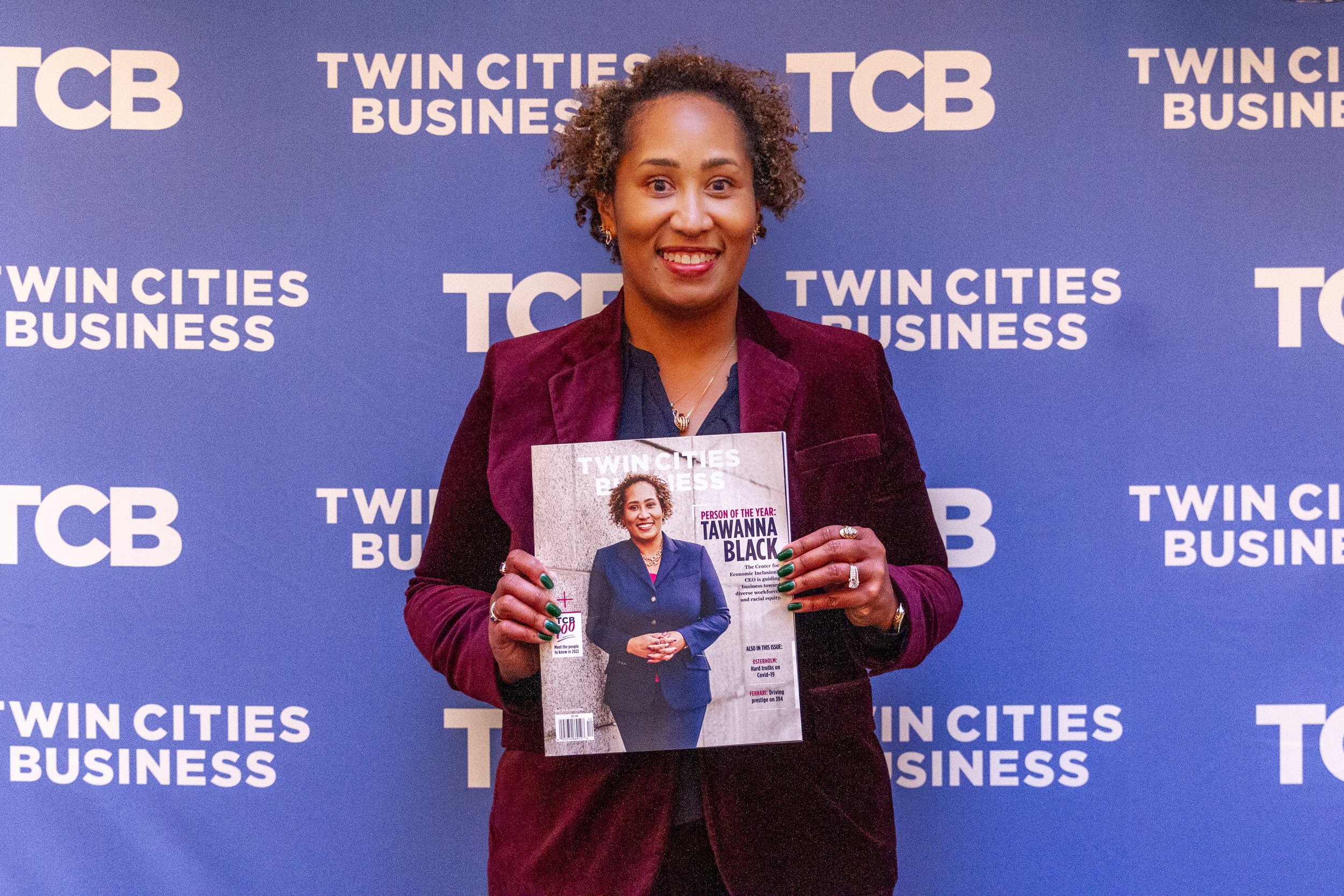
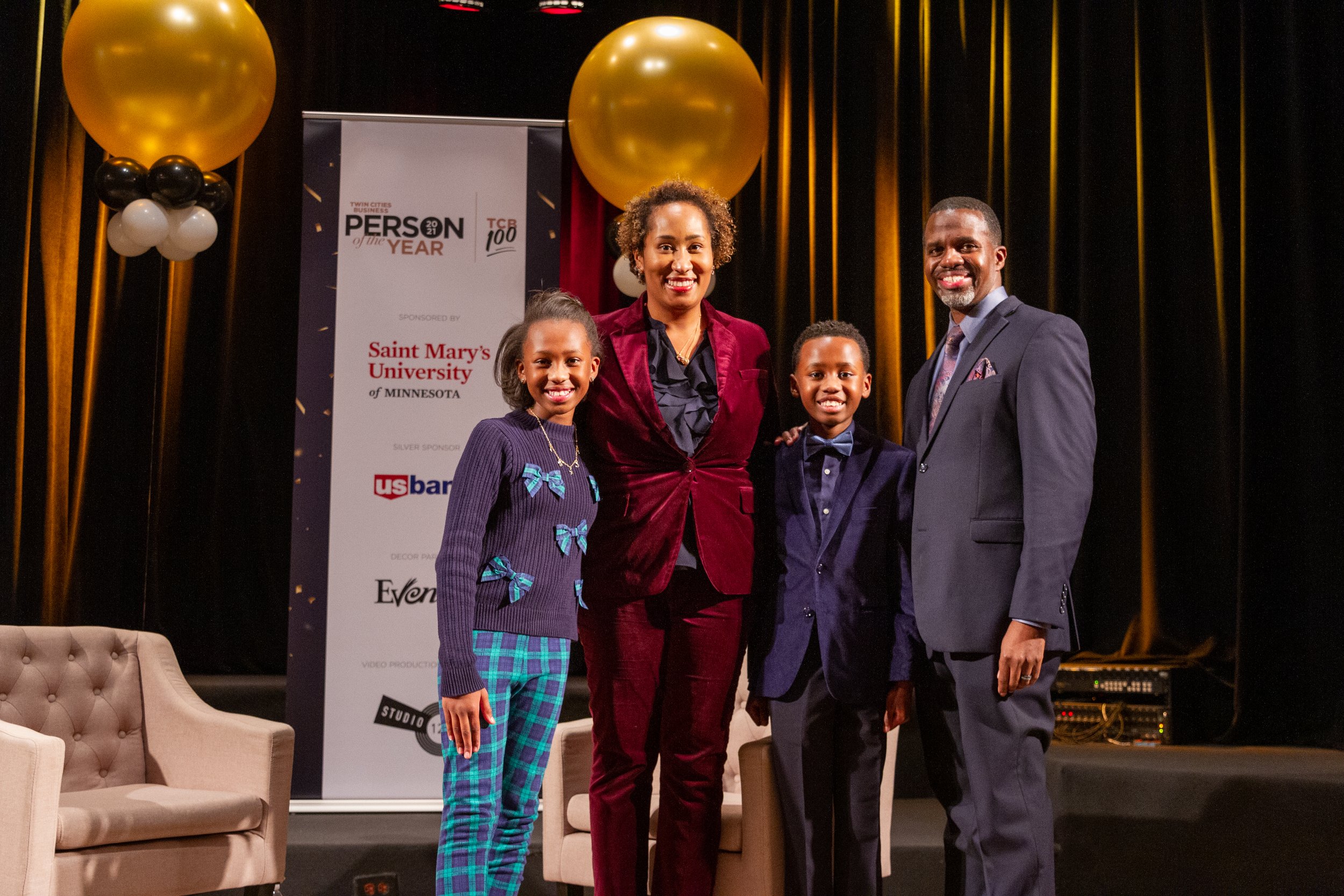
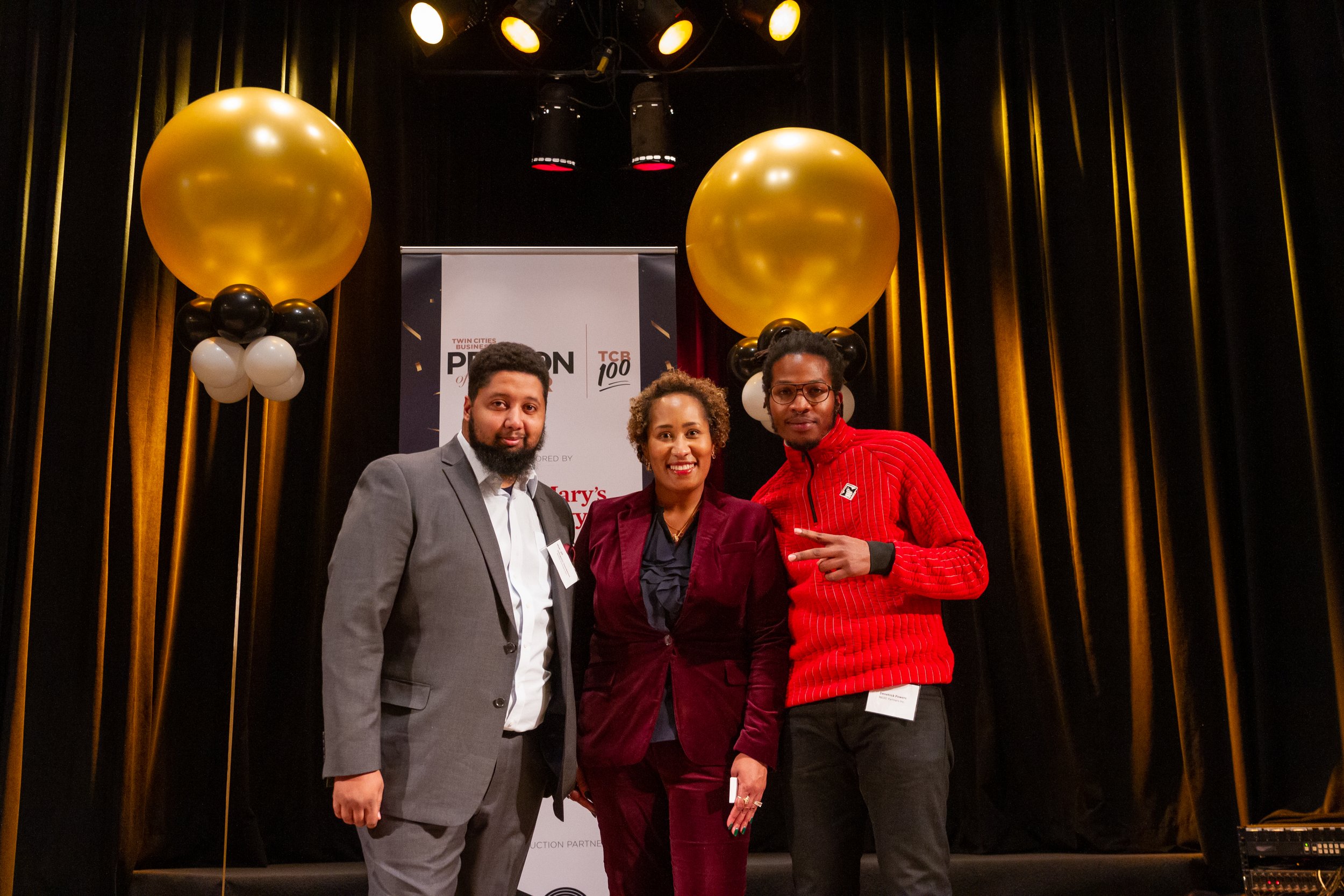
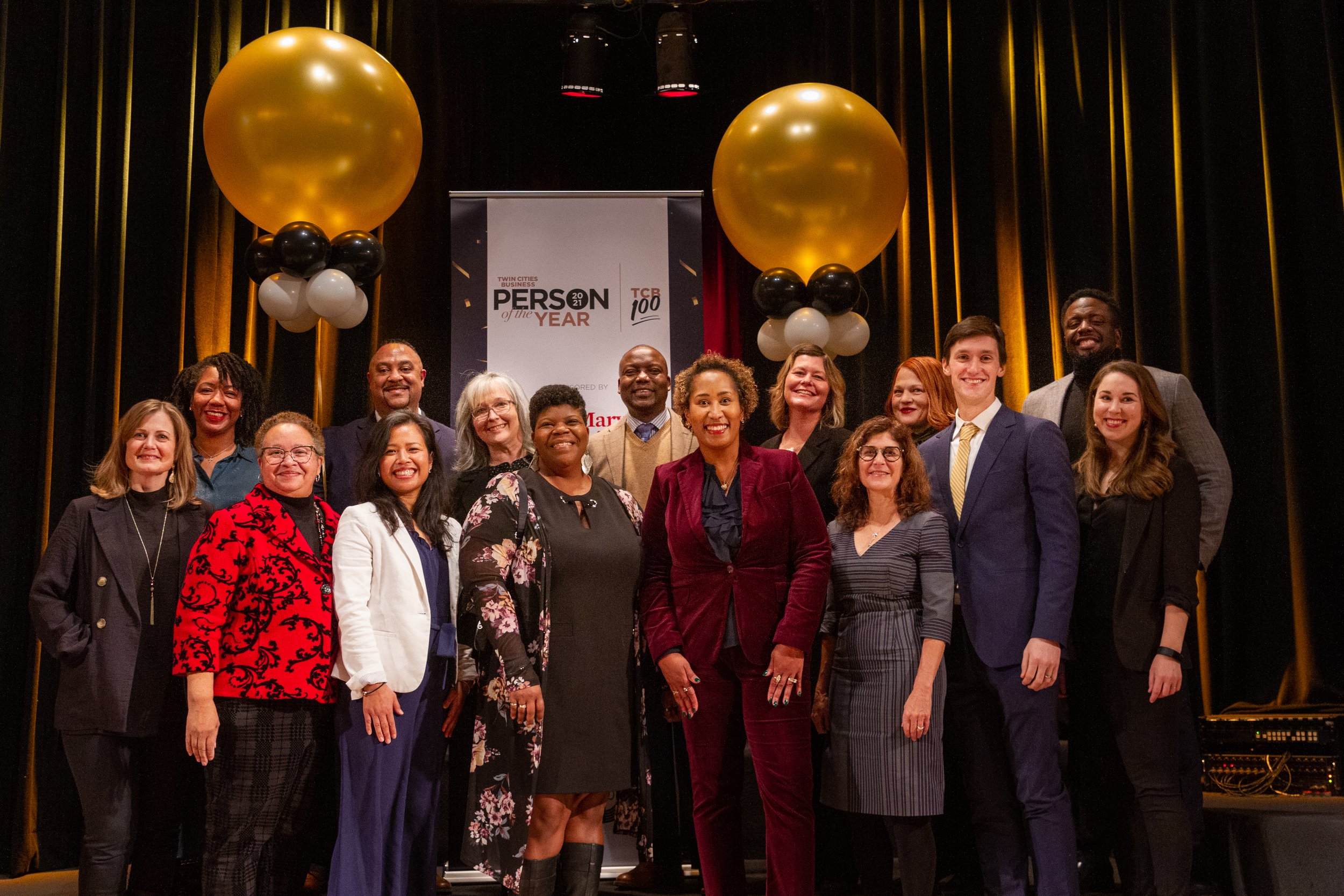
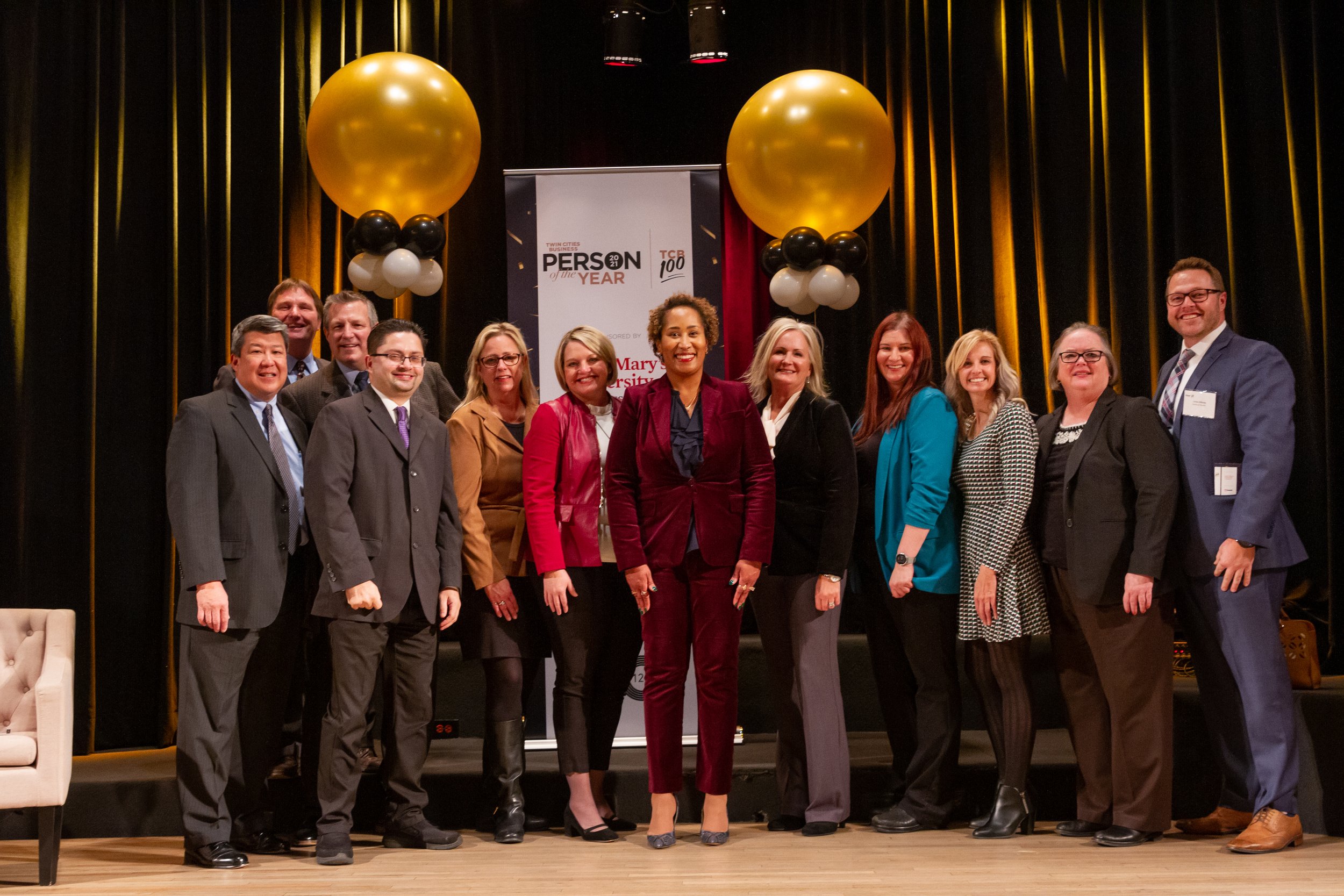
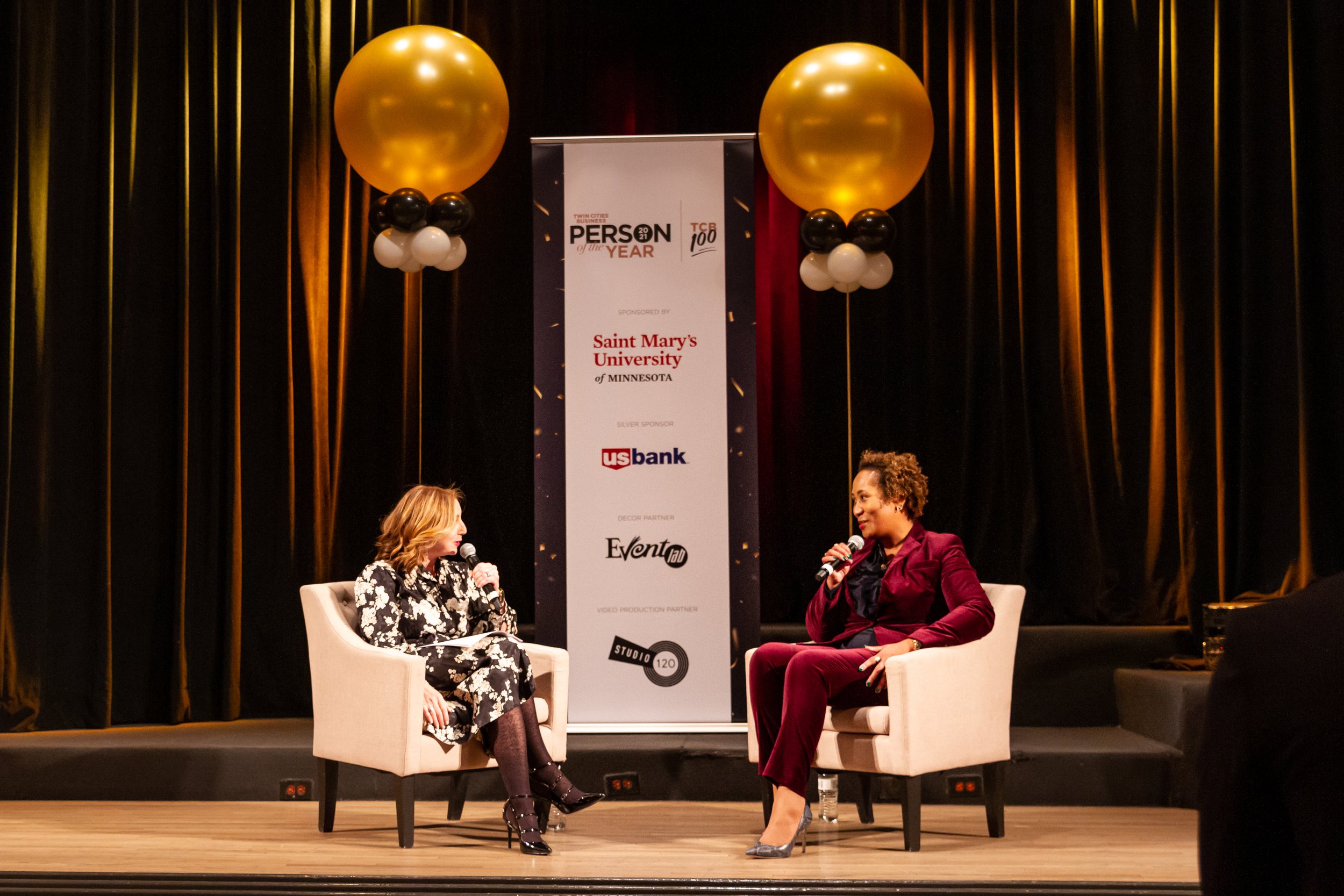


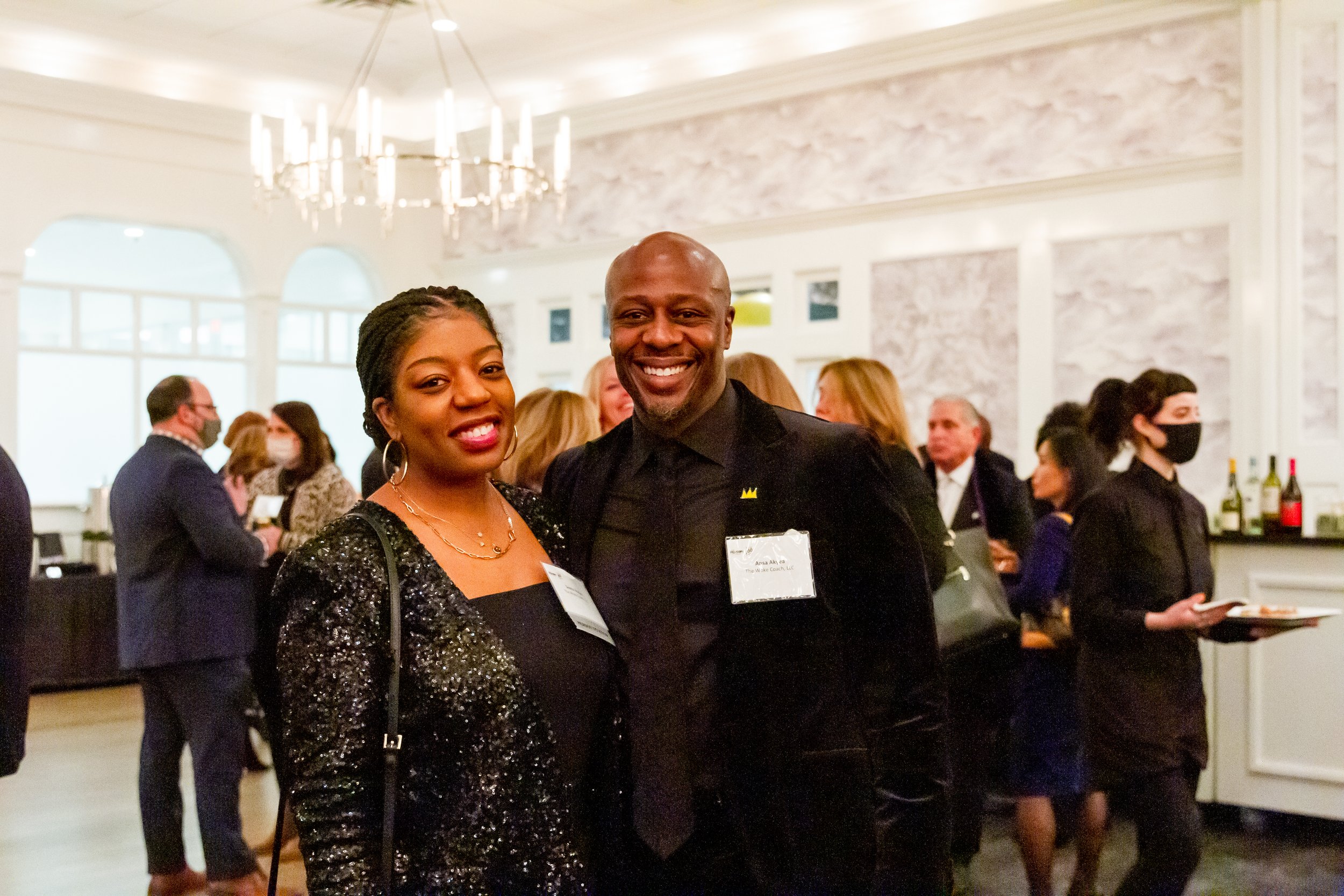


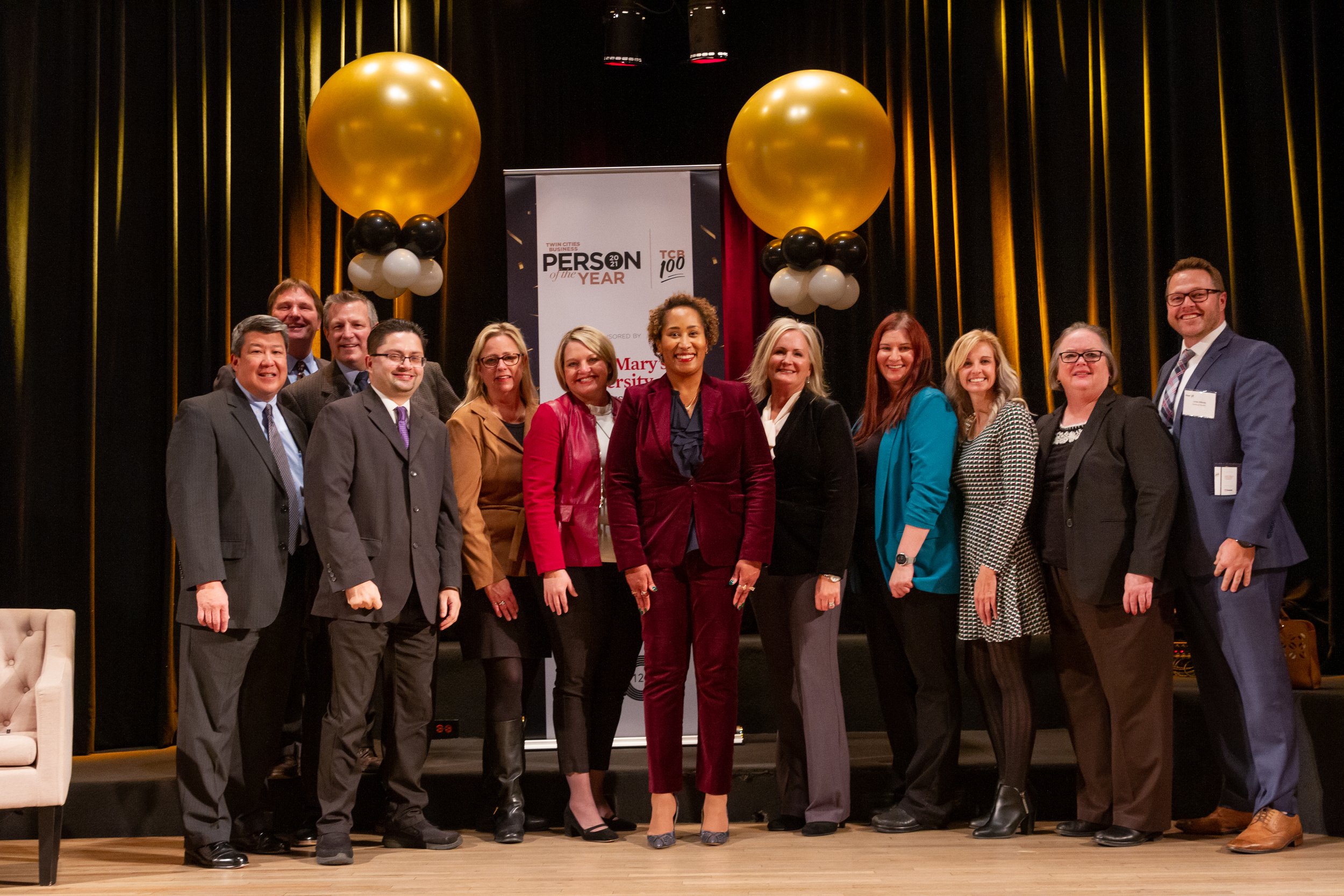
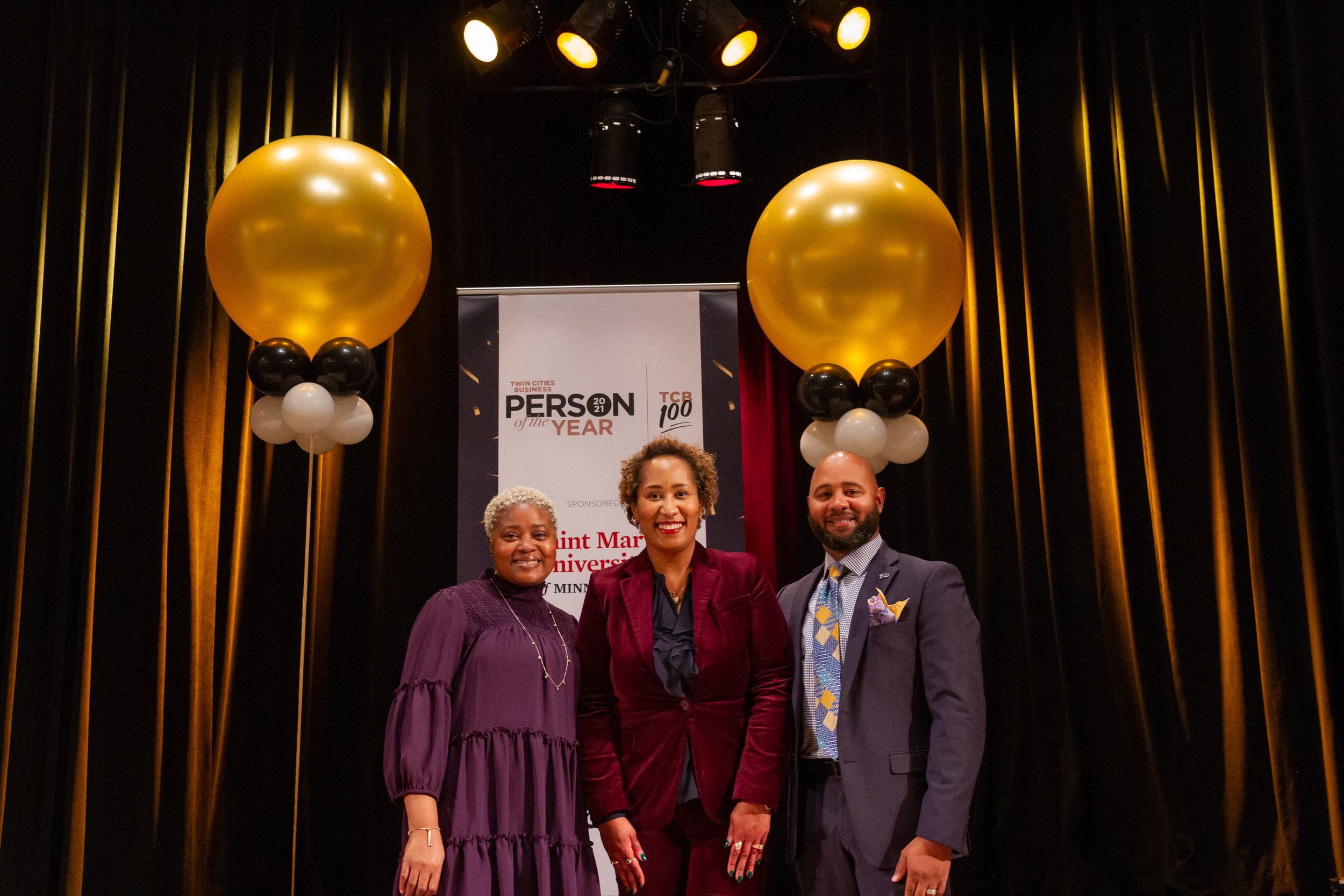
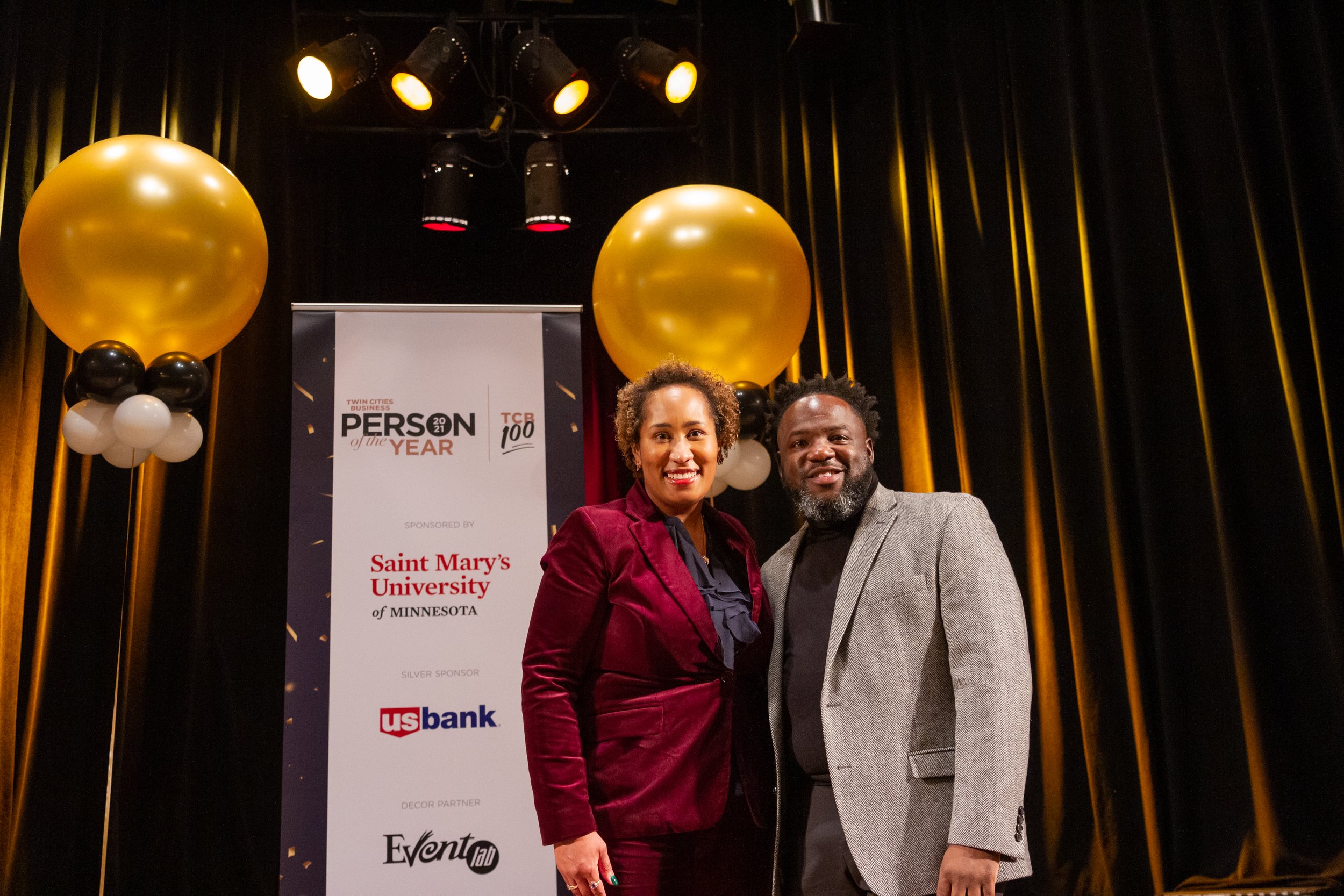
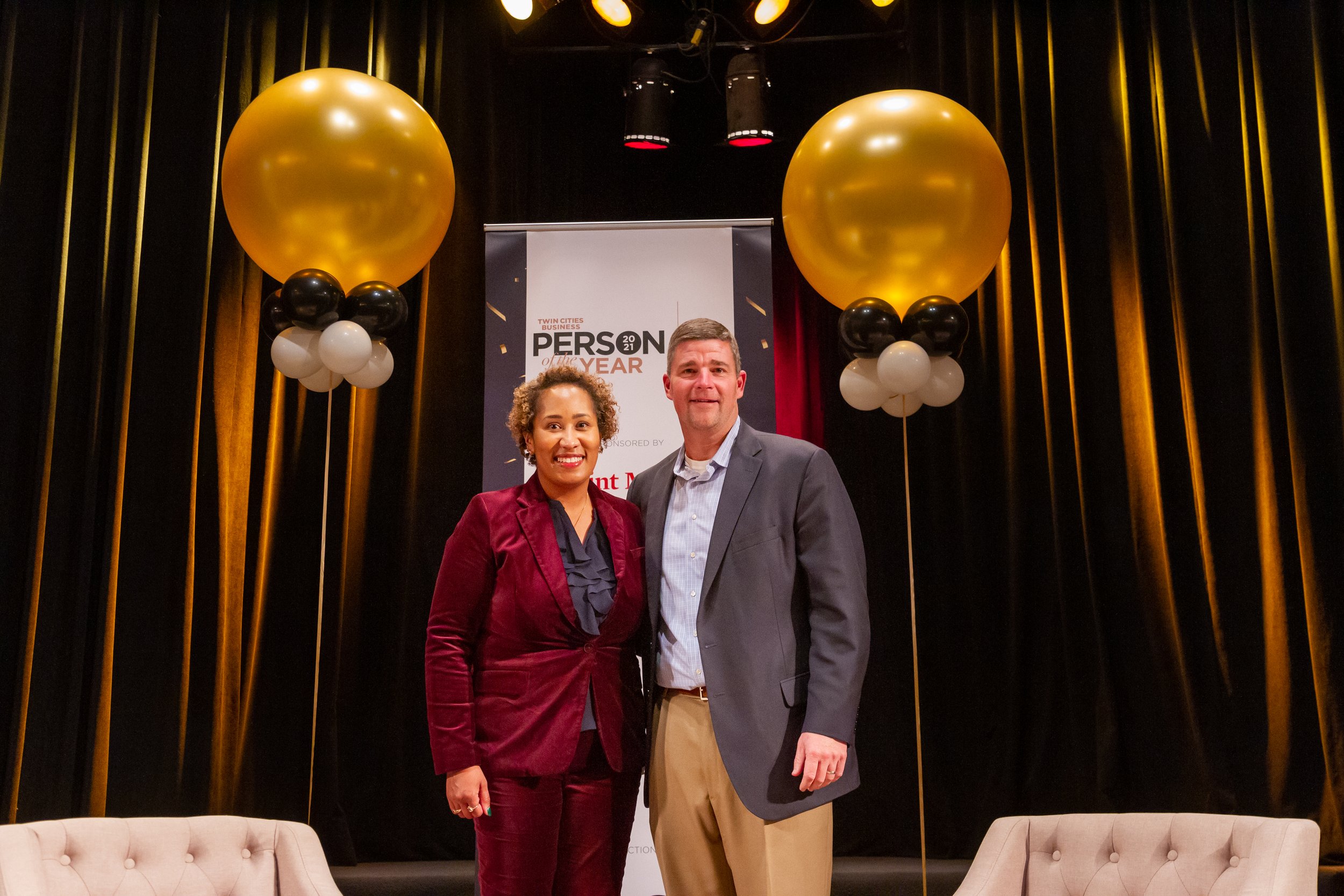
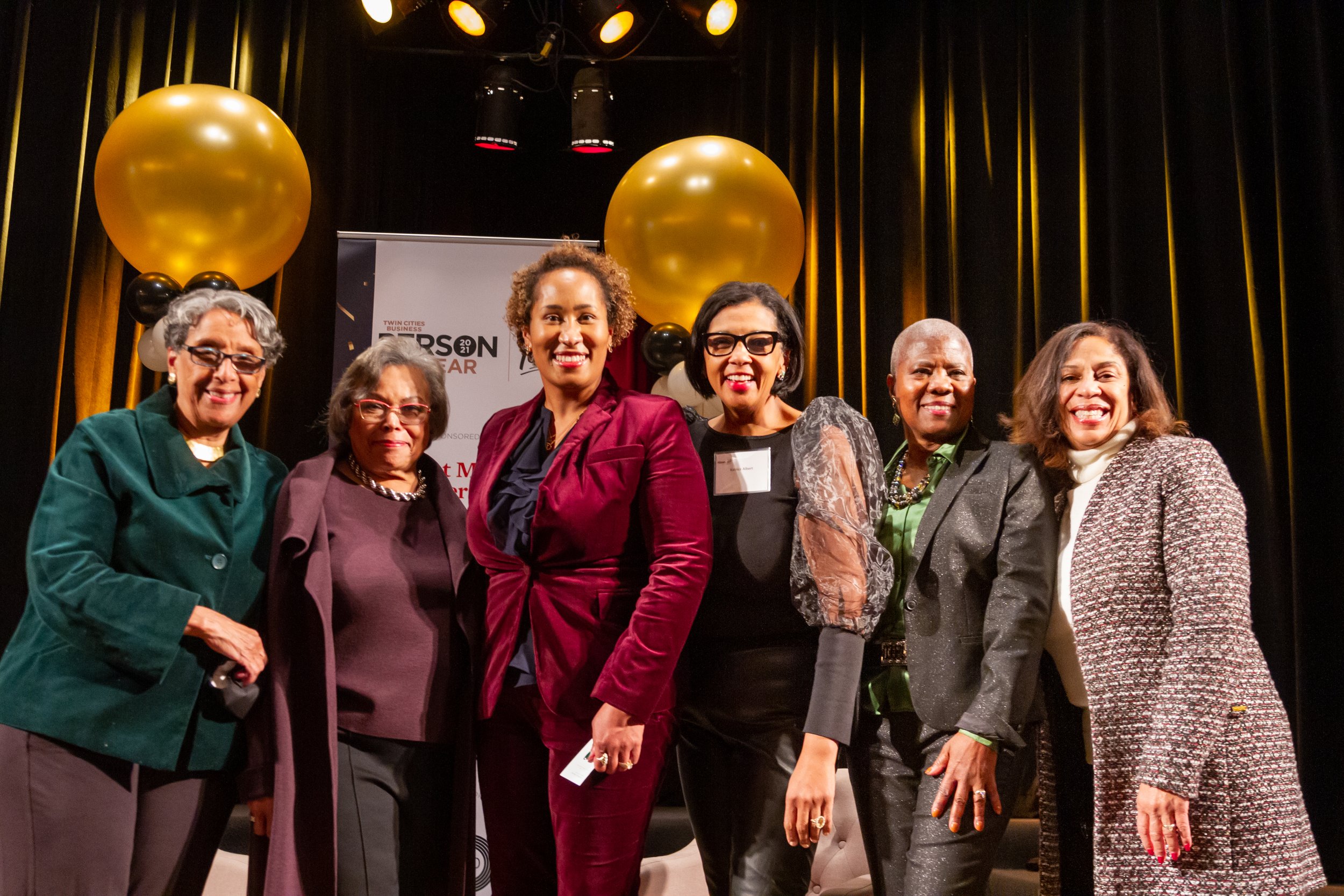

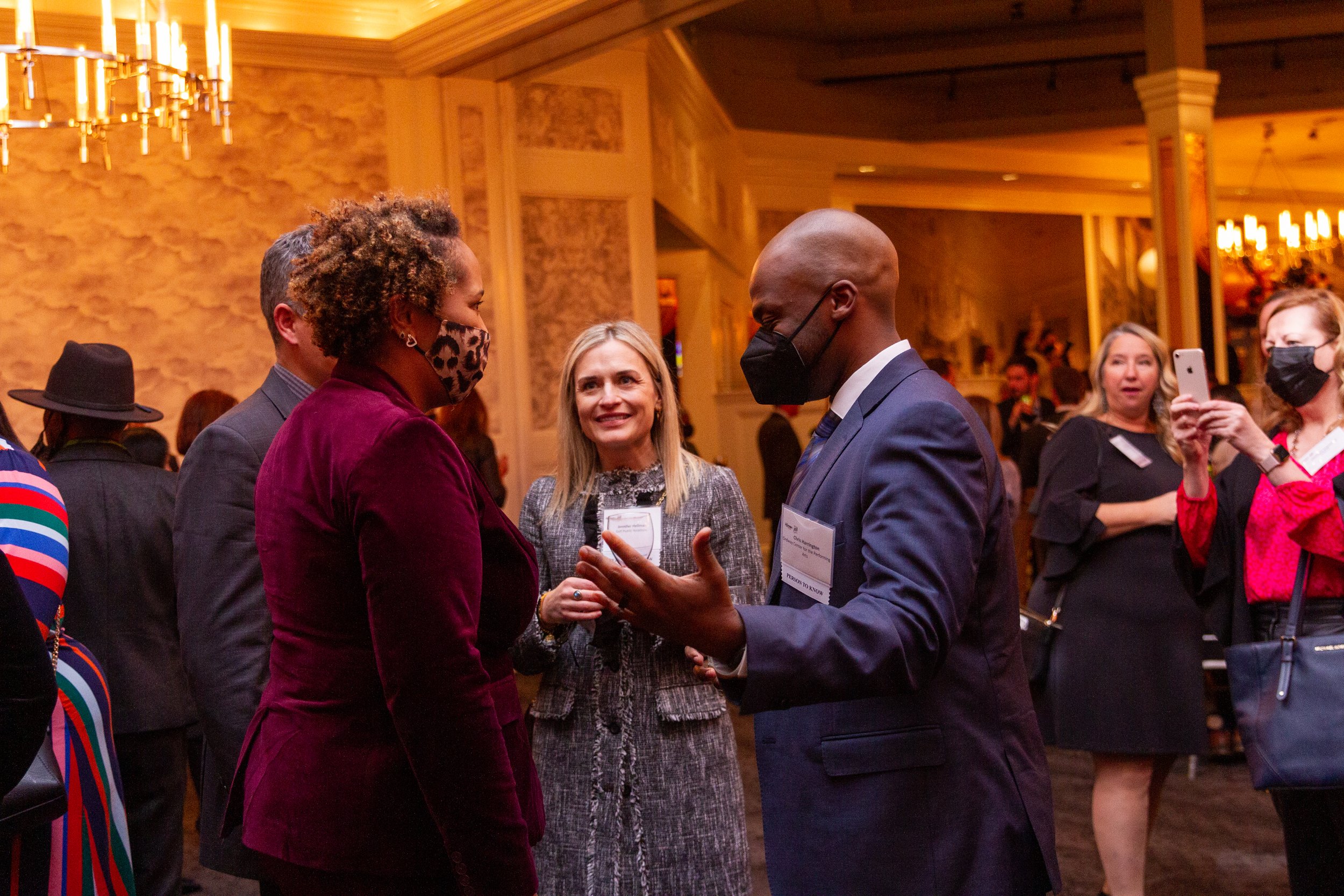
Twin Cities Business also announced its list of the TCB 100: The People to Know in 2021, where Center board members were recognized, including Adair Mosley for his leadership as President and CEO of Pillsbury United Communities, and Dionne Gumbs, Founder and CEO of GenEQTY, a financial technology company that offers a digital lending platform designed to remove barriers for small and medium-sized businesses, particularly those owned by women and other diverse founders, and help them access the resources and funding to be successful
The night concluded with a conversation between TCB editor-in-chief Allison Kaplan and Tawanna. Watch it here:
Introducing the Racial Equity Dividends Index
A new tool to drive and support racially equitable business practices
By Nathan Arnosti, Director of Products and Analytics
Businesses across the country have demonstrated a renewed interest in reckoning with our country’s systemic racial inequities in the 18 months since the police killing of George Floyd. According to a review by McKinsey, approximately one-third of the largest 1,000 companies in the nation made statements in support of racial equity in 2020 and committed more than $66 billion to advance racial equity.
In addition to the moral case for change, more and more leaders understand that racism is bad for business. Companies with racially diverse and inclusive teams perform better than more homogenous organizations. And if racial inequities were eliminated across society, our collective prosperity would grow by trillions of dollars, according to a recent report by researchers at the Federal Reserve Bank of San Francisco.
But moving the needle on racial equity will require more than just well-intentioned statements and donations from business leaders. It requires changes to how businesses treat Black, Indigenous, Latinx, and Asian job applicants, existing employees, suppliers, customers, and communities.
Introducing the Racial Equity Dividends Index
In January 2022, the Center for Economic Inclusion will introduce a new analytical tool that businesses can register for to help them make tangible, durable changes to inequitable internal systems, policies, and practices. The Racial Equity Dividends Index (REDI) will enable businesses to measure their progress on racial equity across seven dimensions: Hiring; Culture, Retention, and Advancement; Procurement; Philanthropy and Investment; Public Policy; Products; and Leadership.
How REDI Works
Businesses that register for the Racial Equity Dividends Index will be evaluated on their progress across 37 racially equitable workplace practices, drawn from the expertise of Center for Economic Inclusion staff and other practitioners at the forefront of corporate racial equity strategies. Businesses then receive a confidential score report, which will identify where they excel and where they fall short compared to peers.
Collectively, this knowledge is essential to guiding future efforts to advance racially equitable and inclusive practices within their organization.
REDI is designed to celebrate and accelerate progress toward antiracism. High-scoring businesses will be publicly recognized and highlighted in an annual Racial Equity Dividends Index Report and included on the Center for Economic Inclusion’s Best Businesses for Racial Equity list.
Availability & Fee
The Racial Equity Dividends Index will be available on an annual basis. In its first year, REDI is available to for-profit businesses with a footprint in Minnesota. In the coming months and years, REDI will be available in other markets.
To register for REDI, businesses are charged a $1,000 administrative fee. More information about the Index and link to registration will be available soon at www.centerforeconomicinclusion.org.
Measurement Matters
Today’s racial inequities are the result of racist and inequitable practices within the private and public sectors, sustained over generations. It will take deliberate action from all of us – including leaders in the private sector – to overcome these harmful patterns and build an economy that works for everyone. Data drives action – and this is what the Index does at its core.
The Center for Economic Inclusion’s Racial Equity Dividends Index is the newest tool we offer to help businesses chart a path to greater racial equity – and profitability. We hope that many businesses in Ramsey County and across Minnesota seize this opportunity to move from a verbal commitment to racial equity and inclusion to meaningful action that gets results.
Learn More and Take the Next Step
Interested in taking the next step to complete the Racial Equity Dividends Index? Contact Jonathan Johnson, Business Development and Strategy Lead, 612.351.8214 and jjohnson@centerforeconomicinclusion.org.
JOIN US: Celebrating Tawanna A. Black, TCB 2021 Person of the Year, Dec. 6 @ 5-7pm
STATEMENT: Our Response to Governor Walz’s Council on Minnesota’s Economic Expansion
(St. Paul, September 14, 2021) Minnesota Governor Walz’s creation of a Council on Economic Expansion and his commitment to take bold action with people at the center is an important step forward in our state’s continued path toward reconciling decades of wealth extraction, economic exclusion, and racism, and the economic harm caused to our state when this persists.
We commend Governor Walz for the proactive commitment to partner with business leaders and trusted community advisors in his efforts to invest the $2.577 billion in American Recovery Plan Act (ARP) dollars entrusted to Minnesota’s elected policy makers. President Biden has led investment and a call for action like no other. This moment of reckoning calls for catalytic and transformational investments to address the devastating impacts of the dual pandemics of COVID-19 and racism on our economy, and to pursue every opportunity to close racial wealth gaps for Black, Indigenous, Latinx, and Asian workers and families.
Over the last six months, the Center for Economic Inclusion has convened over 300 Minnesotans, representing each sector and spectrum of diversity, in roundtable discussions to inform our research and advocacy for racially responsive and relevant local, regional, and state government investments of ARP funds. Minnesotans committed to racially inclusive and equitable growth agree: the time is now for policy makers to make bold investments in not only addressing the urgent needs of Minnesotans and our infrastructure, but also in dismantling the systemic racism within our systems that has allowed racism and economic exclusion to flourish at nation-leading rates for decades.
This has been the most racially unequal economic downturn the United States has ever experienced. Disproportionate impacts deserve proportionate solutions and investments. Pandemic-related layoffs have disproportionately affected women, Indigenous, and Black Minnesotans, and the differences in industry and occupation explain only a fraction of these job losses. According to MN Compass, more than 8 in 10 Black employees and more than 7 in 10 American Indian employees have filed unemployment claims in Minnesota during the COVID-19 pandemic, compared to about 4 in 10 non-Hispanic white employees.
Further, a University of Minnesota study showed that women of color are over-represented in high-risk, low-paying jobs and have born the greatest weight of the disparate impacts of the dual pandemics. The State of Minnesota cannot afford not to make investments in solutions created by and for Black, Indigenous, Latinx, and Asian people, investments that are shown to produce returns for the entire economy.
Black, Indigenous, Latinx, and Asian individuals comprise 23% of the Metro areas labor force, yet constituted 36.6% of UI claims as of September 2020.
Black-white wage gap continues to grow, with a more than 20% increase between 2000 and 2020.
41% of Black-owned businesses—some 440,000 enterprises—have been shut down by COVID-19, compared to just 17% of white-owned businesses nationally.
Four industries most impacted by job contraction and business closures: Accommodation and Food Services, Retail Trade, Health Care and Social Assistance, and Other Services.
Consider this: Had the Black wage, education, housing, and investing gaps been closed 20 years ago, it would have added nearly $16 trillion to the economy, according to Citi. Action today could add $5 trillion to the GDP by 2026. Actions in solidarity with Black people and Black-led organizations that directly assess intent and impact and center racial equity will ensure that Minnesota lives up to our values and ideals and ultimately, closes these persistent gaps.
Unlike resources from its CARES Act predecessor, the ARP offers state and local governments flexibility and a horizon for investing dollars, ingredients that are critical for transformation. COVID-19’s devastating economic impacts on Black and Brown workers and business owners have only compounded a long history of systemic racism and wealth extraction. Now is our time to be on the right side of history, but it will require immediate and sustained investment with racial equity in the center. Investments that close long-standing wage gaps and stimulate business growth in Black, Indigenous, Latinx, and Asian communities will pay dividends for all Minnesotans.
Race-neutral policies and investments will not stimulate economic recovery. Investments must be bold, intentional and specifically focused on strategies to dismantle systemic racism and simultaneously meet the needs of communities who have been left to shoulder the weight of that racism. Minnesota’s economic growth and competitiveness will rely upon the willingness of policy makers to invest in policies, solutions, and strategies that are unique to each racial, ethnic, and geographic population and community with responsive investments in organizations and businesses led by Black, Indigenous, Latinx, and Asian people. Comparable business investments and actions can propel our state forward, and this Council has both the power and the responsibility to champion solutions that will stimulate economic growth and prosperity of all communities.
To aid in identifying, assessing, and selecting racially responsive and relevant investments, the Center advocates for investments to:
Incentivize and nurture the growth of higher–quality businesses and industries, particularly those led by Black, Indigenous, Latinx, and Asian people. Invest directly in efforts led by our communities to stimulate businesses in high-growth sectors that can be leveraged by the corporate procurement commitments made by businesses headquartered here in Minnesota.
Aim to stabilize and strengthen not only neighborhood small businesses, but also tech ecosystems that support Black and Brown entrepreneurs.
Support reskilling, along with career navigation and placement services, to facilitate a racially diverse talent base with access to family-sustaining wages and benefits.
Prevent displacement and increase Black ownership business, property and housing ownership.
Incorporate Racial Equity Impact Note framework in partnership with the Center for Economic Inclusion and Voices for Racial Justice to assess and select investments prioritizing those that will narrow racial employment, income, and wealth gaps and contribute to economic growth.
The Center for Economic Inclusion is committed to partnering with Governor Walz, Council Co-Chairs Paul Williams and Jeff Ettinger, and Council members, in partnership with the House and the Senate, to not only pursue inclusive recovery, but also identify and implement racially responsive and effective policies and approaches that are responsive to the economic opportunity before us. This must include developing and utilizing a tool and inclusive process for evaluating the racial responsiveness of fiscal proposals to accelerate racial equity and shared prosperity and economic growth for all Minnesotans.
2021
###
About the American Rescue Plan
Thursday, August 5, 2021
Host & Convener:
Tawanna A Black, Center for Economic Inclusion
Facilitated Discussion:
Aarica Coleman, Housing and Redevelopment Authority Administrator, City of Bloomington
Mayor James Hovland, City of Edina
Joseph Parilla, Fellow, Metropolitan Policy Program, Brookings
Over the next couple of years, local elected leaders will invest $1.14 billion in American Rescue Plan (ARP) dollars in the Minneapolis-St. Paul region to undo the harm caused by COVID-19 and generations of economic and racial disparities that came before it.
At a Transportation Advisory Board meeting in May, leaders asked if a regional fund for racial equity could best position our region for inclusive economic competitiveness.
On Thursday, August 5, the Center convened with other elected officials and economic development staff to not only explore this idea, but to identify commitments, needs, and opportunities for aligned investment.
List of key takeaways from the discussions:
Balancing our instinct for urgent action with this opportunity to slow down and be thoughtful, planful, and dream with community.
Committing to intentional listening -- prioritizing communities and community voices.
Focusing on the "how" of funding allocation decisions more than the "what."
Calling for bold leadership from elected leaders who are charged with deploying and investing dollars.
Ensuring all actions we take are transformational, not transactional, and have a multiplication effect.
Evaluating and measuring the impact of ARP dollars already committed.
Ensuring that accountability is central and achieved in solidarity.
Media Coverage
Finance & Commerce attended and covered the convening. Click here for the article.
Full Discussion Video
New Initiative Launched to Support Inclusive Workplaces
Learn more at employer information sessions, July 29 & August 2
Ramsey County, in partnership with the Workforce Innovation Board (WIB), is launching the Inclusive Workplaces Cohort. This new initiative, in alignment with the Economic Competitiveness and Inclusion Plan, will support businesses in becoming more inclusive workplaces to ensure we are amplifying the diversity of our community as a tool for economic growth.
Twenty (20) businesses in Ramsey County will have the opportunity to participate in a 10-month peer learning cohort while advancing equity and inclusion in their organizations.
The Center for Economic Inclusion will lead the experience by creating a learning environment that fosters discussion and sharing of ideas, while encouraging accountability through safe and brave spaces for confidentiality. We will also provide skilled facilitation to guide participants’ learning journeys using a comprehensive racial equity lens and the levers of systems change.
The first cohort will be launched in October with 20 local businesses, with preference given to businesses with 100 or fewer employees. Businesses from all industries are encouraged to apply by Friday, August 6, 2021.
Please share this information with your networks and help us get this opportunity to businesses!
Details about the project and the application for interested businesses can be found at ramseycounty.us/InclusiveWorkplaces.
Want to learn more? Join us for an upcoming employer information session!
Thursday, July 29, 10-10:45 a.m.
Monday, August 2, 2-2:45 p.m.
Legislature failed to enact key racial equity measure
Op-ed by Tawanna A. Black, Brett Grant, and Vayong Moua
(This article first appeared in the Minnesota Reformer on July 20, 2021.)
Public policy is a powerful tool for justice. It drives regional, state and federal investments that impact communities and the economy. When racial equity and economic inclusion are not prioritized and considered with intention in policymaking, the result is often inequitable policies, a loss in economic growth, and harmful impacts to Black, Indigenous, Latino and Asian communities.
You do not have to look very far to find examples of policies in housing, transportation, infrastructure, education, business development, and more that have excluded, devalued and even destroyed the economic opportunity and vitality of Black, Indigenous, Latino and Asian communities, and in so doing harmed Minnesota’s economic growth and competitiveness.
New analysis released last month by the Federal Reserve shows that if we closed racial gaps — in earnings, hours worked, educational attainment, and employment — Minnesota’s gross domestic product (GDP) would have increased by $6.6 billion annually from 2005-19. This equates to $92.4 billion in lost GDP during this period, an economic loss that hurts all Minnesotans.
Minnesota’s policymakers had an opportunity during this legislative session to take action to gain a portion of that $6.6 billion of annual GDP, and they failed.
Instead, efforts to close racial equity gaps fell victim to polarized and antiquated views of economic growth and competitiveness.
During the session, the Center for Economic Inclusion in partnership with Voices for Racial Justice, Blue Cross Blue Shield of Minnesota, and the Racial Equity & Joy Coalition, fought for the passage of “racial equity impact notes” legislation. Just as a fiscal note helps lawmakers understand how a piece of legislation would affect the state’s finances, racial equity impact notes would help them see how a given bill would ameliorate or worsen racial equity. Doing so would be a way to guarantee future policies reflect and ensure racial equity and inclusion before being passed into state law.
Given Minnesota’s global position at the center of a new era of racial reckoning and atonement following the murder of George Floyd by Minneapolis police, we believed Minnesota was ready for racially equitable and inclusive policies. Considering the state’s ranking as one of the worst for people of color in almost every dimension of economic prosperity and quality of life, state legislators had every reason to make good on their promises to do everything possible to take meaningful and decisive action.
In the end, enough of them stood in the way, deciding racial equity was not a priority, and the measure failed.
The reality is that our demographics are changing across the state, and our policies and investments must recognize not only this change but also the historical context alongside today’s systemic barriers when designing policies and targeting investments.
A recent survey of 2,051 likely voters in Minnesota in early 2021 by Data for Progress showed that 61% supported funding for racial equity. That’s because Minnesotans increasingly recognize the actions and investments needed to achieve our aspirations for racial equity, while too many legislators are maintaining the status quo at the expense of economic growth.
We see, for example, continued inter-generational impact caused by wealth extraction, under-capitalization, and over a century of exclusive policies and practices that have resulted in the nation’s highest racial homeownership gap in the Twin Cities. According to a recent report by the Urban Institute, Black homeownership in Hennepin and Ramsey counties fell 10 percentage points between 2000 and 2018, while the rates for white homeownership remained relatively unchanged. That same report found roughly one-fifth of Black households own their homes, compared with nearly three-quarters of white households.
What actions would Minnesota legislators have taken to narrow that racial homeownership gap if racial equity impact notes would have been in place?
Racial equity impact notes are a powerful, common-sense tool. They would ensure consistent analysis, leverage community expertise, and facilitate informed decision-making through use of a set of guiding questions to determine if existing and proposed policies and investments would increase or decrease racial disparities.
Racial equity impact notes are also about accountability, in the sense that legislation should be data-informed, community-informed, and analyzed to account for potential impacts for the people the legislation seeks to serve, or the problem the legislation seeks to resolve. Unintended consequences come into play for all policy, and trade-offs within policy analyses can and should consider race in the context of ongoing, historic, and deeply rooted inequities and exclusion.
Consider how past policies like the Homestead Act or the construction of Interstate Highway 94, which benefited white communities while devastating Black, Indigenous, Latino, and Asian communities, would play out differently if we knew from racial equity impact notes how they would affect those communities.
Legislators in collaboration with Black, Indigenous, Latino, and Asian communities hold a shared responsibility to develop, pass, and measure policies that embody equitable valuation of Black, Indigenous, Latino, and Asian life, leadership, entrepreneurship and neighborhoods.
Data show the ripple effect of policy decisions rooted in racism, demonstrated by our region’s failure to move the needle in any measurable way on systemic racial disparities in nearly every major facet of our economy, despite the state’s much vaunted prosperity. This promise of a great quality of life is experienced most completely by white residents and families. Until Black, Indigenous, Latino and Asian lives are valued as human beings, Minnesota can expect the symptoms of racism to continue to escalate.
Minnesota would not be a test case for racial equity impact notes. Nine states — Iowa, Colorado, Connecticut, Florida, Oregon, Maine, Maryland, New Jersey, and Virginia — have implemented mechanisms for the preparation and consideration of racial equity impact notes. We have models to provide guidance, with the promise of positive impacts toward racial equity. In Oregon, after passing legislation, they later implemented a racial and ethnic impact statement in their voter’s guide regarding a drug decriminalization initiative. The ballot measure passed, decriminalizing small amounts of all drugs.
A recent poll commissioned by Blue Cross Blue Shield of Minnesota found that 42% of Minnesotans do not believe racism is a significant issue in our state. Perhaps some of those Minnesotans wonder how a standardized racial equity assessment in policymaking would benefit them.
Policies designed to facilitate access to sustainable jobs, community assets and wealth building, would translate into a stronger tax base and more spending power that benefits all Minnesotans.
Minnesota has a responsibility to all residents to uproot racism for shared prosperity. Let’s leverage the might of the majority of Minnesotans who believe we must do everything we can to ensure racial equity and inclusion as a first order of business.
A year after George Floyd’s murder, corporate promises haven’t made Minneapolis more equal
By Tawanna A. Black and Amy Liu
Editor's Note: This post was originally published on Quartz on May 28, 2021.
Tawanna A. Black - Founder and Chief Executive Officer, Center for Economic Inclusion
The Minneapolis-St. Paul metro area is home to over a dozen Fortune 500 companies, including Target, 3M, and General Mills. But in a matter of years, this global headquarter region has become a flashpoint of racial hostility from police brutality, with the murders of Philando Castille in 2017, George Floyd in 2020, and Daunte Wright in 2021.
It’s been one year since the murder of George Floyd, an event that reshaped the nation and forced millions of Americans to finally grapple with systemic racial injustices. One would think that the rush of corporate commitments to improve Black lives would at least take root in Minneapolis-St. Paul. It has not.
Amy Liu - Vice President and Director - Metropolitan Policy Program, Brookings
This past winter, one of us attended a meeting in Minneapolis-St. Paul with Fortune 500 and large corporate CEOs and Black business executives to identify opportunities for corporate action for racial equity. After 90 minutes of discussion about the challenges and opportunities before us, the meeting’s facilitator asked a poignant question: “What is your aspiration for what success of our work should look like?”
Black executives named dismantling institutional racism and envisioned partnerships with CEOs and corporations to achieve measurable results such as closing regional wage gaps, representation in executive ranks on par with Black representation in the market, and creating an equitable standard of living between Black and white Minnesotans. They aspired to achieve results that required anti-racist actions on the part of employers and elected leaders.
In contrast, white executives in the room aspired for less tangible results grounded in meritocracy. They envisioned equal opportunity, the satisfaction of knowing they made a difference, and creating a world where merit informed how people moved up or down the economic ladder. The dissonance in the experiences and aspirations of Black people and white people was palpable, and not new to those leading anti-racism and economic justice organizations around the country.
For decades, in Minneapolis-St. Paul and cities like it all over the country, corporations have been forming partnerships and coalitions to address the byproducts of racism such as unemployment, substandard K-12 education, inadequate housing, and health disparities. While some of these initiatives have produced programmatic results, most have not moved the needle for Black and brown people. To bring about real, measurable, and lasting change, corporate leaders must commit to internal and external actions to undo the systemic racism entrenched in the communities their customers and workers call home.
Unfortunately, in the past year, corporations have prioritized highly visible national equity campaigns and philanthropic commitments over the harder, needed work to dismantle systemic racism inside their businesses and in the communities in which they operate. Consider the communities that could benefit from deep and sustained actions to improve equity: Louisville, Ky. (Breonna Taylor), Columbus, Ohio (Ma’Khia Bryant), Brunswick, Ga. (Ahmed Aubrey), Chicago (Adam Toledo), Sacramento, Calif. (Stephon Clark), Baltimore (Freddie Gray), St. Louis/Ferguson, Mo. (Michael Brown), Turtle Mountain Indian Reservation, N.D. (Brandon Laducer), and Atlanta (Xiaojie Tan, Daoyou Feng, Hyun Jung Grant, Suncha Kim, Soon Chung Park, Yong Ae Yue, Delaina Ashley Yaun, Paul Andre Michels), to name just a few.
Consider the trends in Minneapolis-St. Paul, which are not unique to the Twin Cities. For a major hub of global commerce, the region has one of the widest earnings gaps between whites and people of color, ranking 46th out of the 53 largest metro areas in progress on this score, according to Brookings. Black and Asian American workers are massively underrepresented in management and rapidly growing medical and tech occupations in Greater Minneapolis-St. Paul, at a time when the private sector says they are diversifying C-suites and workplaces overall. Meanwhile, less than 3% of Black, Latino or Hispanic, and Asian American adults in the metro area own businesses, according to the Center for Economic Inclusion.
These trends cannot be reversed by siloed corporate investments or ad hoc hiring goals. Confronting them requires intentional, coordinated actions among employers and nonprofit partners, driven by quantifiable goals reflecting the unique challenges in that community.
First, CEOs and private sector executives in home regions must set regionwide quantifiable goals that they can achieve together. This could include workforce, supplier, and investment goals that target the 4% of all occupations that account for more than 60% of the overall value of the Black wage gap, making a significant impact on closing racial disparities in housing, education, and health.
This process must be data-informed and done in partnership with Black leaders who can provide credible guidance for goal setting and strategy. For instance, as hiring accelerates in the post-COVID digital jobs boom, CEOs could use this window to double the share of Black workers employed in growing computer and science occupations. This is particularly pressing in greater Minneapolis-St. Paul, where African Americans make up 7.8% of the region’s workforce but only 3.8% of computer-oriented positions.
Second, once goals are set, corporate coalitions and CEOs should collaborate with key nonprofit and government partners to develop strategies to achieve those goals, including regularly monitoring progress on performance metrics. By working in partnership, CEOs’ pooled demand could accelerate results and drive pressure to address systemic bias in workforce training, land-use policy, and access to capital for business growth and real estate development.
Collective CEO action could also create solutions in which there have been historic gaps, such as large-scale efforts to invest in and scale minority-owned firms in high-growth sectors. Doing so would expand the pool of business partners in corporate supplier diversity initiatives and provide intergenerational wealth-building opportunities for residents. One model is Cincinnati’s Minority Business Accelerator, where CEO partnerships have led to investment in 70 high-growth African-American-owned businesses, resulting in the creation of 3,500 jobs and over $1 billion in revenue.
Lastly, but perhaps most importantly, CEOs must be willing to lead differently inside their corporations and embed an anti-racist lens into every facet of the business. Past failures have not occurred due to lack of good intent, but due to organizations that lacked leaders with the skills to fully nurture racial equity and inclusion as business imperatives. CEOs must be bold in their efforts to build a pool of executives and supervisors with the skills to manage for inclusion, equity, and belonging.
Some corporations are taking these proactive steps to dismantle internal racism and promote inclusion in their communities. Target has established a multifaceted internal advisory committee to ensure all employees are grounded in its commitment to racial equity. U.S. Bank has developed strategies for increasing Black wealth, homeownership, and business development, and announced increased philanthropy in Black communities and investments in Black businesses in its hometown of Minneapolis. These efforts are a good start, but must continue for years to undo generations of racism and wealth extraction.
Even the boldest of corporate epiphanies will go nowhere if they do not work hand-in-hand with the politicians writing the laws. Here is where leaders can harness the critical flexibility of the American Rescue Plan’s $350 billion in state and local recovery funds—investing in policies to close long-standing postsecondary education and wage gaps and stimulate homeownership and business growth in Black, Indigenous, Latino or Hispanic, and Asian American communities. Leaders must use this moment to develop the capacity of existing institutions or new partnerships with credibility in Black and brown communities to ensure a racially inclusive economic recovery plan.
Though collective CEO action in regions is just beginning, several notable examples of regional collaboration are Minneapolis’ Anti-Racism and Economic Trust, the Corporate Coalition in Chicago, and Business Equity for Indy.
As we continue this journey in Minneapolis-St. Paul, we are keenly aware that one police officer found guilty still leaves us far from the end of this story. The past year has shown us that while we’re moving in a better direction, corporate actions will only result in measurable change if they are rooted in place, co-created with Black people, and have defined, shared aspirations.
In short, tangible improvements in racial and economic equity at the local level is where corporate credibility — and overall national progress — will ultimately be judged.
REFLECTIONS ON A YEAR OF RECKONING | Makram El-Amin
MY REFLECTIONS
By Makram El-Amin - Executive Director, Al Maa'uun; Imam, Masjid An-Nur
The murder of George Floyd last May brought conversations about racism, front and center. Racism, police brutality, systematic racism, institutional racism, you name it, all these things have come forth.
The response to his murder is emblematic of the pressure and oppression Black folks have felt for generations in this country. This past year has brought everything to a head and calls us to engage more deeply in conversations about race and how it shows up in our lives.
It is so prevalent in every aspect of our lives, and it does not matter what we are talking about. When you look at things through the lens of race for Black people and Brown people, the situation gets worse no matter what the subject is. Whether it is economics, health, or education. The area and construct of race being discussed, within the context of that subject matter, shows how widespread this issue really is and how baked it is into our society.
We all have a stake in this. Everyone must lean in. No one can be a bystander. We are at a point where those who are not actively working against racism and the oppression of Black and Brown people, you are basically on the opposite side. There is no sideline or bystander that I can tolerate in this conversation.
Shared accountability means no matter what your vantage point or privilege, you recognize racism as an issue and confront it in your daily life.
Race is an issue we are taking head on. At the Masjid An-Nur Mosque, I have spoken about it from the pulpit. We have had webinars, lectures, and presentations regarding race, and how it shows up in faith and the work we do.
It cannot be denied how this has worked itself into every part of society. Minnesota will be forever different, seen as ground zero in the struggle for racial equity and justice, particularly relative to George Floyd. While this issue is not new and predates George’s murder, something is different. This moment needs capturing and leveraging for the betterment of us all.
The future holds what we make it hold. Successful Black neighborhoods and businesses need to become commonplace. This happens from within Black and Brown and greater society. Then, we will start to move the needle on other things.
Nothing will come to us simply by asking. We must demand it. Until we do, the outcomes will be the same and we will continue to get the same things we have always gotten. We need to change the narrative and conversation. Then and only then, will we begin to see the needle move on issues of race, bigotry, discrimination, and oppression.
ABOUT THE REFLECTIONS CAMPAIGN
After a year of reckoning with the ravages of racism in our schools, businesses, neighborhoods, and halls of justice, we see clearly that racism is deeply woven into every fiber of our society and that the consequences have touched each person in America. We see the depths of division and racism and the imperative to work in new ways to address very old problems.
The Center for Economic Inclusion invited leaders at all levels and from across sectors to share their reflections of the past year; several members of the Center’s staff have also participated. We wanted to learn how they have reckoned with racism over the past year; what is different in the places where they live, work, and play; what they think the the future holds; and what they think it will take to reimagine and build an economy that truly works for everyone.
We thank the leaders who answered our call to participate in this campaign. All week long, we will share their powerful reflections, in their own words.
> To engage with our entire Reckoning to Rise Together series, click here.
REFLECTIONS ON A YEAR OF RECKONING: Alice Roberts-Davis
My Reflections
By Alice Roberts-Davis - Commissioner, Minnesota Dept. of Administration
Sometimes when I’m cleaning a room in my home, I drag everything out to the middle of the floor. I sort through it. I organize it. I decide what I should hold on to and what I need to let go of. Only then do I start to meticulously put things away, vacuum the carpet, and spray the air freshener.
I wonder if that’s where we are as Americans, all our dirty laundry in the middle of the floor for the rest of the world to see. The racism that has been shoved under the bed for decades and the stark disparities between Black and white previously hidden in a drawer are all now on international display.
Perhaps this is the catalyst that will put our country on a different course – an opportunity to proverbially “clean house.”
What many of us have experienced quietly throughout our lives has been thrust into the broader community’s consciousness. In so much sadness and anger, we have seen many new allies join us and decry the many fouls against us.
I believe that shared accountability and people from all races calling for an end to systemic racism by using their voices, their money, and their votes to support a more equitable America, is a huge step in the right direction.
This gives me hope.
The past year has been extremely painful and extremely emotional. As we start to put away those things that we have decided to hold on to, we must remember that the point of cleaning is to put them away with space for what’s new. New thoughts, new ideas, new positive energy should reclaim the space of what was once there.
I pray that racism exists only in the old America and that we are creating a new America with a bright and shiny future for all.
ABOUT THE REFLECTIONS CAMPAIGN
After a year of reckoning with the ravages of racism in our schools, businesses, neighborhoods, and halls of justice, we see clearly that racism is deeply woven into every fiber of our society and that the consequences have touched each person in America. We see the depths of division and racism and the imperative to work in new ways to address very old problems.
The Center for Economic Inclusion invited leaders at all levels and from across sectors to share their reflections of the past year; several members of the Center’s staff have also participated. We wanted to learn how they have reckoned with racism over the past year; what is different in the places where they live, work, and play; what they think the the future holds; and what they think it will take to reimagine and build an economy that truly works for everyone.
We thank the leaders who answered our call to participate in this campaign. All week long, we will share their powerful reflections, in their own words.
> To engage with our entire Reckoning to Rise Together series, click here.
